















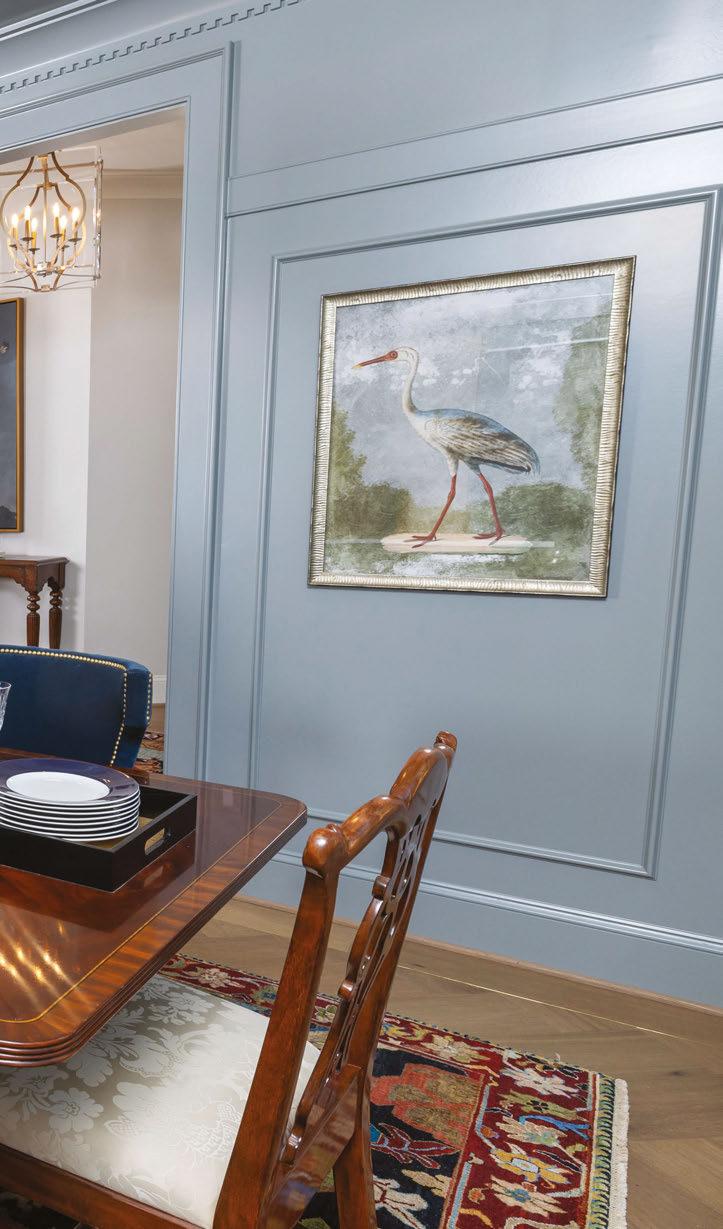
Custom Built Home by Exeter Building Company featured in the 2023 Parade of Homes / Furnishings by Theodore Alexander, Chelsea House, Hickory White, Leftbank Art and hand-knotted rug from India
Home is where the best holiday memories are made. Gathered around the dining room table, curled up on a comfy sofa or simply relaxing in the warmth of a cozy room. Before family arrives this season, prepare your home for the holidays with handcrafted furniture, rugs and home décor at Green Front Furniture in Raleigh.
Visit us today to experience more than 30,000 square feet of unique furniture, accessories, hand-knotted rugs, and luxurious upholstery.




We believe that beautifully ordered spaces in the home bring peace, comfort and joy. That’s why this holiday season we’re giving WALTER readers the gift of $500 off their minimum purchase of $2,500 at California Closets. Book a complimentary design consultation with one of our designers today.* 919.785.1115








57 Reduced for Quick Sale by Susan Willey Spait illustration by Canain Stanley
58 The Angus Barn’s Christmas Tradition
A look inside the holiday bedazzling of the iconic restaurant by Hampton Williams Hofer photography by Trey Thomas

70 A Deeper Roast
Areli Barrera Grodski and Leon Grodski Barrera brew conscious spaces for community by Finn Cohen photography by Taylor McDonald
78 Earthen Vessels
Ben Owen III carries on a family tradition to work in clay by Liza Roberts


A course unlike any in the Pinehurst canon, No. 10 arrives in its full, natural splendor mere weeks ahead of the 2024 U.S. Open. Experience Tom Doak’s bold design beginning April 3, 2024 with our Premier Golf Package, where you can play No. 2, No. 10 & The Cradle . . . and unlimited additional rounds.*

In October, we learned that our September 2022 issue won an OZZIE for Best Design for a Single Issue in the City/Regional Magazine category! We are super proud to have won this national magazine award. Here’s a photo of us toasting at Raleigh Wine Shop — which, coincidentally, had just been named one of Wine Enthusiast’s Best Wine Shops of 2023!
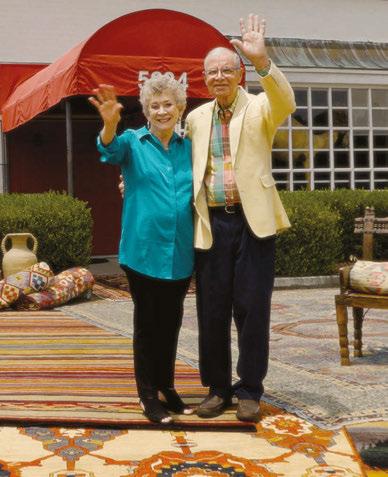
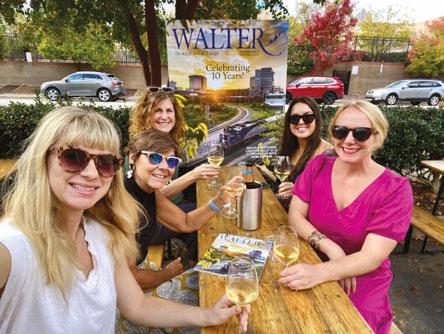
Acouple weeks ago, we took a trip out to Linville. My kids were hell-bent on hiking part of the Grandfather Mountain Profile Trail. They’d heard there were ladders, and, playground enthusiasts that they are, figured they could tackle it. So we parked near the Swinging Bridge and headed up to MacRae Peak. The first part of the path was a steady climb with some rocky spots. There were cables to hold on to when it got steep. We were excited to reach the first ladder, a fun little challenge up an angled rock. After a bit, we got to the next ladder, up a slightly steeper rock. Everyone gamely climbed up: first my husband Josh, then my youngest, then my oldest, with me as the caboose. We hit a third ladder, then a fourth, each a little steeper. But at the fifth ladder, I made the mistake of looking to my left. There, beyond the rock we were climbing, was nothing. No trees or dirt, just a beautiful view. I looked up. The next ladder, the steepest one yet, led to a lot more nothing. The wind seemed to pick up. I felt a little queasy. I gripped the well-worn wooden ladder and called to my oldest, “Do you want to stop?” I got a vigorous nod, yes. So we got off the ladder and flattened ourselves against the rock on a little ledge, holding hands and trying not to look down, or out. The other two didn’t look back.
A few hikers passed by on their way up or down; some seemed as scared as we were, but they kept moving. Another hiker, a man about my parents’ age, joined us on our ledge. The three of us talked until we’d calmed enough to descend. But it wasn’t until I felt pine needles under my feet that my pulse started to slow.
We started chatting with our fellow hiker and his wife, who’d been waiting for him at the bottom. We learned that they were visiting from southern Alabama, and they told us all about their three children, 14 grandchildren and seven great-grandchildren. I snuck glances up the mountainside, where the other two were nowhere to be seen, and said a few prayers while I listened. The thought occurred that I hadn’t heard any shouting, so probably no one saw an 8-year-old blow off a cliff. I also worried that she was too scared to come down, and that I’d have to go help her.
But finally, finally, Josh and our youngest made their way down, unharmed.
Pretty soon after, the Alabama couple waved goodbye — and I realized that they had been lingering just to keep us distracted. They had spent an hour of their vacation talking to us, total strangers, just to make sure we were OK. What a gift!
I’m grateful for that, and it’s a reminder, especially in the holiday bustle, that sometimes the best gift we can give to others is our full, unhurried attention.
 Ayn-Monique Klahre Editor
Ayn-Monique Klahre Editor






DECEMBER 2023
Editor
AYN-MONIQUE KLAHRE ayn-monique@waltermagazine.com
Creative Director
LAURA PETRIDES WALL laura@waltermagazine.com
Associate Editor
ADDIE LADNER addie@waltermagazine.com
Contributing Writers
Finn Cohen, Catherine Currin Jim Dodson, Mike Dunn
Ilina Ewen, Hampton Williams Hofer
Susanna Klingenberg, David Menconi Liza Roberts, Rachel Simon Susan Willey Spalt
Contributing Poetry Editor Jaki Shelton Green
Contributing Copy Editor Finn Cohen
Contributing Photographers
Alex Boerner, Liz Condo, Christine Harrigan, Taylor McDonald, Matt Ramey, Trey Thomas, Jerry Wolford
Contributing Illustrators
Jillian Ohl, Gerry O’Neill Canain Stanley
Publisher DAVID WORONOFF
Advertising Sales Manager JULIE NICKENS julie@waltermagazine.com
Senior Account Executive & Operations CRISTINA HURLEY cristina@waltermagazine.com
Events Coordinator KARLIE MARLOWE events@waltermagazine.com
Finance STEVE ANDERSON
910-693-2497
Distribution JACK BURTON
Inquiries? WALTER OFFICE 984-286-0928
Address all correspondence to: WALTER magazine, 421 Fayetteville Street, Suite 104 Raleigh, N.C. 27601
WALTER is available by paid subscriptions for $36 a year in the United States, as well as select rack and advertiser locations throughout the Triangle. Subscribe online at waltermagazine.com/subscribe
For customer service inquiries, please email us at customerservice@waltermagazine.com or call 984-286-0928
WALTER does not accept unsolicited manuscripts.
Please contact Ayn-Monique Klahre at ayn-monique@waltermagazine.com for freelance guidelines.
Owners
JACK ANDREWS, FRANK DANIELS III, LEE DIRKS, DAVID WORONOFF In memoriam FRANK DANIELS JR.
© WALTER magazine. All rights reserved. No part of this publication may be reproduced in any form without the express written consent of the copyright owner. Published 12 times a year by The Pilot LLC.




Duke
Boost
World-class
Only 50 girls accepted

puzzles through her Etsy business, YourCrossword. She’s written for The New York Times, Vice, NBC News and more, and is the author of 2022’s Pickleball for All: Everything But the “Kitchen” Sink. A New York native and graduate of Emerson College, she lives in Raleigh with her husband and pets. “I’ve always loved how many fun and unique ways there are to celebrate the holiday season in Raleigh, and I had a great time incorporating many of them into the puzzle. Happy solving!”
Taylor McDonald is a photographer with a focus in commercial, fine art and architectural work. In 2015, she graduated from The Savannah College of Art & Design with a BFA in photography. She now resides in Durham and shoots a variety of subjects. Her personal and professional work seek to explore humanity and the places we call home. “Areli and Leon, the creative duo behind Cocoa Cinnamon & Little Waves, gave me an entirely new perspective on coffee. It is much more than a morning ritual; it is a sacred tradition steeped in culture and connection.”
 TREY THOMAS / PHOTOGRAPHER
TREY THOMAS / PHOTOGRAPHER
A lifelong passion for architecture and interior design, coupled with a serious love of photography, led to Thomas switching careers in 2012 to focus exclusively on interiors and architectural photography. “My friends and I traditionally enjoy a meal during Chritmastime at The Angus Barn, so I was particularly excited for this shoot. While I’m familiar with the decor, it was quite an adventure roaming around the restaurant during off hours. It allowed me to appreciate the enormity and attention to detail like never before. Each year, the restaurant is transformed into a winter wonderland and there’s truly nothing like it in the area.”

Connor modeling his Halloween costume, which appeared in our October issue. “We had so much fun with it! You won’t find a bigger Char-Grill fan,” says his mom, Pamela Brown.
“I wanted you to know how much I appreciate the monthly poem. I love the variety of the topics and especially enjoyed What I Kept in the October issue. Much of that poem resonated with me and my relationship with my mom, and I’ve shared it with numerous friends. Thank you!”
— Genie Safriet
“Congratulations and well deserved, Preeti! I enjoyed reading the article and seeing your beautiful smiling face on the cover.”
Vanessa Guirguis
“You guys are doing a fantastic job. I love the content shared on your IG page. It feels quite wholesome and shows a lot of thought put into it.”
— Sanchali Agarwal





End 2023 on a high note with festive shows, artisan markets and homegrown music.
by ADDIE LADNER
A CHRISTMAS CAROL
Dec. 8 - 17 | various times
Theatre In The Park’s beloved adaptation of A Christmas Carol celebrates its 50th anniversary this month, but there’s another significant milestone: Director and actor Ira David Wood III will give his final performance as Ebenezer Scrooge after playing the role for as long as the show has been running. “Fifty years have flown by in the wink of an eye. It has been an honor and privilege to have been part of a production that has become such a holiday tradition. How deeply humbling to think that so many people have made us part of their celebration of the holiday season,” says Wood. The play has become known nationwide for weaving modern humor around current events into the musical adaptation of the Charles Dickens classic. While it’s enjoyed critically acclaimed tours to England and France, locals can enjoy it right in their hometown with performances at both the Martin Marietta Center for the Performing Arts and the Durham Performing Arts Center. From $35; 2 E. South Street, Raleigh or 123 Vivian Street, Durham; theatreinthepark.org
Dec. 1 & 4 | Various times
The best women’s college soccer teams will converge at Cary’s WakeMed soccer park this year for two rounds of games to determine the national champions. This will be the 11th year that North Carolina has hosted the Women’s College Cup. Soccer fans can look forward to four different local food trucks and top-notch athletes taking the field. Let’s hope that this year’s matches are as thrilling as last year, when the University of California, Los Angeles beat the University of North Carolina at Chapel Hill by one point in overtime. $35; 101 Soccer Park Drive, Cary; ncaa.com

Dec. 1 - 17 | Various times
Based on the fairy tale by Charles Perraul, kids of all ages will love this comedic, musical retelling of Cinderella Enjoy memorable characters including Cinderella’s outrageously spoiled stepfamily and the Fairy Godmother’s hapless helpers. Experience the show that has captivated families for almost 40 years. From $28; 301 Pogue Street; raleighlittletheatre.org
Dec. 9 | 8 p.m.
Chapel Hill-based Southern Culture on the Skids will bring its retro rock jams back to the Triangle at iconic venue
All information is accurate as of press time, but please check waltermagazine.com and the event websites for the latest updates.

All month | Various times
It’s shopping season! Holiday markets are a great opportunity to shop for products from local makers, and each has its own vibe. The Boylan Heights Artwalk is a sprawling, quirky sale that takes place on the porches and front yards of residents’ homes in the funky, historic neighborhood. Wander it to find handcrafted goods from wooden vessels to ceramic jewelry to paintings to photographs. (Dec. 3 | 12 - 5 p.m.; free admission; Boylan Heights neighborhood; boylanheights.org) WALTER’s Celebrate the Season offers an upscale shopping experience with the energy of a holiday party. Set at CAM this year, guests can expect a modern, artful atmosphere, along with festive food and beverages from Blackbird Brewery and Westgate Wine and Catering Works. Keep an eye out for some familiar faces you’ve seen in the pages of the magazine! (Dec. 6 | 6 - 9 p.m.; $25; 409 W. Martin Street; waltermagazine.com/celebrate) The Holiday Market at The Durham Hotel returns with tons of hip Triangle brands in the Bull City hotel’s retro-styled lobby. Proceeds from the market will benefit Y Learning from the Durham YMCA, an afterschool program designed to keep kids from falling behind in school. (Dec. 6 | 6 - 9 p.m.; $10; thedurham.com) In addition to showcasing handmade goods, Theatre Raleigh’s Holiday Market will include live entertainment from its upcoming show, The 1940s Radio Hour, and guests can grab a festive drink at the bar. (Dec. 3 & 10 | 11 a.m. - 3 p.m.; free admission; 6638 Old Wake Forest Road; theatreraleigh.com) The Mayton Holiday Market is a family-friendly option with a photo opp with Santa in the hotel’s library and 20 local vendors. For an adults-only outing, head to the Peck & Plume bar for live music and festive drinks for purchase. (Dec. 6 | 3 - 6 p.m.; free admission; 301 S. Academy Street, Cary; themayton.com)
Cat’s Cradle. As it’s been for the past three decades, you’ll find Rick Miller on guitar and vocals, Mary Huff on bass and vocals and Dave Hartman on drums. The band will mostly perform tracks from its latest record, At Home with Southern Culture on The Skids, which was recorded in Miller’s living room and produced at the height of COVID-19. Doors open at 7 p.m. $18; 300 E. Main Street, Carrboro; catscradle.com
Dec. 9 & 10 | Various times
Experience the story of the birth of Jesus told through West African and contemporary choreography and music at the North Carolina Museum of Art’s amphitheater. Each year the production includes new elements but holds true to the Langston Hughes original, rooted in gospel music. This year, Justice Theater Project artistic director
Jerry Sipp says to look out for some familiar faces and hymns but also a few new songs and cast members, plus an all-new set backdrop. “Our friend Gerald Rubin, a Triangle area AfricanAmerican artist, will be helping to augment the look of our set with his unique painting vision,” Sipp says. $5; 2110 Blue Ridge Road; justicetheaterproject.org
Dec. 9 - 10 | 1 - 7 p.m.
Step inside 10 different centuries-old homes in Craftsman and Victorian styles during the Historic Oakwood Candlelight Tour in the City of Oaks’ oldest neighborhood. Each year, a few Oakwood residents open up their homes for the public to learn about history and architecture and share how the homes are being used in the present day. The tour includes cookies

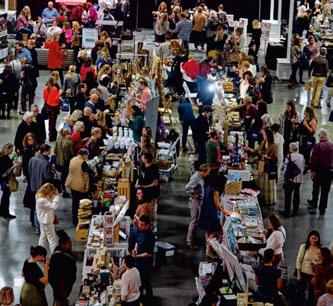
and hot apple cider at check-in and performances by the Oakwood Waits, a group of carolers in period costume. From $45; N. Bloodworth Street & Oakwood Avenue; historicoakwood.org
Dec. 12 | 7:30 p.m.
Hear a wide range of carols including “We Wish You a Merry Christmas,” “Hark the Herald Angels Sing” and, as a favorite finale, “Joy to the World,” at the North Carolina Master Chorale’s Joy of the Season concert. With more than 170 voices between the symphonic choir, chamber choir and youth choir, along with a live orchestra, this evening will be sure to get you into a spirited mood. From $32; 2 E. South Street; ncmasterchorale.org
MENORAH LIGHTING
Dec. 13 | 5:30 - 6:30 p.m.
Area residents are invited to join a

special Menorah lighting during Hanukkah outside the Cary Arts Center in partnership with the Beth Shalom congregation, Jewish Federation of Raleigh-Cary and Chabad of Cary. Bring the kids to enjoy live music, festive snacks and activities. “We’ll have a sing-along, crafts and dreidels. The treats usually include chocolate gelt and sometimes we have sufganiyot,” says Jennifer L. Hocken, program specialist with the Town of Cary. Free; 101 Dry Avenue, Cary; carync.gov
Dec. 13 - 24 | Various times
This musical by Walton Jones depicts a live final broadcast of a fictional holiday musical variety show in the ballroom of the Hotel Astor in New York City. Set in the wintertime of the early 1940s, when the world was at war, this particular broadcast is for the troops overseas. A producer finds himself in way over his head dealing with a stumbling singer, a delivery boy who begs for a chance on air and a trumpet player who bails to go fly a fighter plane. Even still, the show drums up feelings of nostalgia, humor and warmth. Theatre Raleigh alumna Julia Murney, an actor, singer and director who has played the role of Elphaba in Wicked on Broadway, will return to direct the show. “My hope is that when the curtain falls, the
audience feels like they have a warm cup of cider. This music will transport them into a mood filled with comfort and reprieve from the stresses of the holiday season,” she says. From $30; 6638 Old Wake Forest Road; theatreraleigh.com
Dec. 14 | 7 p.m.

Want an idea for a cozy athome date night this month? Tune in to an hourlong cocktail tutorial with Shannon Healy, owner of Durham’s Alley Twenty Six, a 2022 finalist for a James Beard Foundation’s Outstanding Bar Program award. The virtual class, themed Sparkling Seasons, will show participants how to mix and pour festive cocktails in the style of classics like the Kir Royale, French 75 and Tom Collins. $15; virtual; alleytwentysix.com





Universal Design is the intentional creation of spaces that cater to a wide range of ages and abilities. These spaces anticipate both present and future needs, as the people who reside transition from one chapter to the next. At Paragon Building Group, we specialize in Universal Design, Inclusive Design, Aging-in-Place, & Multigenerational Living. Using these principles, we build a legacy with our clients, crafting tailored estates that embrace every stage of life, anticipating their lifestyle, needs, and dreams for years, and generations, to come. Taking Universal Design a step further, we integrate these principles seamlessly with an elevated style, turning what others may see as design challenges, into remarkable design miracles.


Dec. 14 - 25 | Various times
Experience captivating choreography, masterful props and costumes and a live orchestra at the Carolina Ballet’s production of THe Nutcracker. “This production is inspired by holiday Americana, keeping the magic of the story alive and connecting us to the nostalgia of our youth. This year, we’re presenting costumes that are more beautiful than ever and reintroducing audience favorites like Mother Ginger,” says Carolina Ballet CEO Zalman Raffael. Catch this local interpretation of the historic fantasy at the Martin Marietta Center for the Performing Arts. From $25; 2 E. South Street; carolinaballet.com
Dec. 31 | 8 p.m.
North Carolina band Avett Brothers is bringing its New Year’s Eve show to PNC Arena with special guest Marcus King, a Grammy-nominated country soul musician from Greenville, South Carolina. While the band has performed a New Year’s Eve concert for more than 20 years, this will be the first time since 2017 that the group has performed at PNC. From $64; 1400 Edwards Mill Road; pncarena.com





DRI has provided state-of-the-art imaging services for nearly 40 years. Now in the Raleigh area, we hope you will let us care for you and your family. We o er immediate appointments and exceptional care in a beautiful, comfortable environment.
Cardiac Scoring
Lung Screening
Virtual Colonoscopy
Wakefield Professional Plaza 11009 Ingleside Place Suite #103, Raleigh 919.521.8311
Hours: Monday–Friday, 8am to 5pm DR I healthgroup.com

Dec. 31 | 8 p.m. - 1 a.m.
Ring in the new year with panoramic views of downtown Raleigh’s skyline and fireworks! The Willard Rooftop Lounge will host its third annual New Year’s Eve extravaganza with an American-themed buffet, live music by jazz band Peter Lamb and the Wolves and dancing. Party favors will be provided and there will be a midnight champagne toast. $155; 9 Glenwood Avenue; thewillardraleigh.com
Dec. 22 - 23 | 9 a.m. - 9 a.m.
Oakwood24 is a unique all-day race at the Historic Oakwood Cemetery, where supporters are invited to spend the entire day running or jogging at their own pace or participate in timed 6-hour, 12-hour and 24-hour challenges. Now in its sixth year, the Oakwood24 charity run has raised over $500,000 to help support recovery from drugs and alcohol through its host organization, Healing Transitions. It’s a race that invites community awareness but that’s also meaningful for people who have gone through Healing Transitions’ programs. “The fact that I am clean and sober today is the reason I was able to run 56 miles,” says Felix, a race participant who completed his course over 19 hours. “I would have never been able to do that. For me, Oakwood24 symbolizes the obstacles of learning how to live sober, pushing through and coming out on the other side — a victory.” From $50 donation to run competitively; 701 Oakwood Avenue; healingtransitions.org



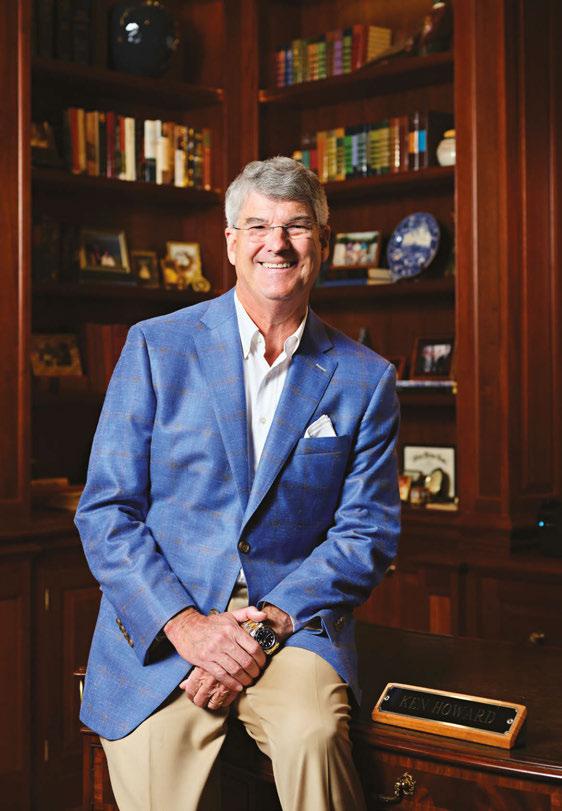
When a fast-paced, numbers-driven marketing executive sets his sights on a history museum, change is sure to follow. Fitting, really, since change is one of history’s constants.
Ken Howard took on the role of director of the North Carolina Museum of History in 2007 after a career in the healthcare sector, including serving as senior vice president of sales and marketing at Medic Computer Systems, Inc. in Raleigh. He believed from the start that history education should be fun, interactive and engaging, so if you’ve ever shivered at the Blackbeard exhibit,
Ken Howard reflects on his 16 years as director of the North Carolina Museum of Historyby SUSANNA KLINGENBERG photography by ALEX BOERNER
posed with the plaza’s Civil War cannon or lifted a well-curated glass at History + Highballs, you have Howard to thank. Howard retired from his post in early October, so we spoke to him about his tenure and what the future holds.
WHEN YOU REFLECT ON YOUR 16 YEARS AS DIRECTOR, WHAT ARE YOU MOST PROUD OF?
From my years in business, I have always been a numbers guy. I wanted to find a way to increase visitation. If we increased visitation, we increased the number of people learning about NC history.
When I arrived in 2007, the museum was seeing 250,000 visitors a year. But
by 2019, just before COVID, we had built visitorship to 465,000 visitors a year.
The key was making it a more interesting museum — bringing exhibits people would want to come see, exhibits that were fun, not just a case of artifacts and a panel on a wall. So, we started with an exhibit on the Lost Colony. It was very interactive, entertaining and engaging for all ages. It brought over 50,000 people to the museum just for that exhibit.
When I got there, the museum didn’t have a permanent exhibit on the history of the state. So we conducted a fundraising campaign, along with some state funding, to build the current “Story of North Carolina” exhibit.
THIS IS TECHNICALLY YOUR THIRD RETIREMENT. WHAT CONVINCED YOU TO LEAVE YOUR SECOND RETIREMENT FOR THE JOB?
It’s a funny story! While I was employed in the health-care industry, I’d been the treasurer of the museum’s membership group, the Museum of History Associates. I had retired from my marketing job, and Lisbeth Evans, the secretary of cultural resources at the time, called me and the chairman of the group to discuss fundraising for the museum. And I said, “Look, it’s hard to raise money when the museum is not having new exhibits. The museum needs to create new and better exhibits.”
A while later, she called again and said, “The director’s going to be retiring. You’re not doing anything. You need to come in here and run the museum.”
I was going quail hunting with my mentor, Frank Daniels Jr., and Dave Phillips, the former state commerce secretary. “You know,” I told them after dinner, “I’ve been asked to take this job.” Dave said, “It’s something you should do.” And Frank said, “It’s your turn to give back.” “You really think so?” I asked. And they emphatically agreed. So I called Secretary Evans and said, “OK, I’ll try it for six months.”
I found out later that she knew about the hunting trip, and she’d told Frank and Dave, “I need you to talk Ken into taking this job.”
She stacked the deck. And after six months, I thought, you know, I like history. I love North Carolina. And it was a good challenge: “How do I make the museum stand out? How do we keep it fresh?”
Those questions are what have kept me there for 16 years.
This job confirmed something I already knew: history education is so important. Look at current events. We’ve been here before, haven’t we? We’ve got to look

back and say, “We’ve seen this. Let’s learn from what we did the first time.” People might not know all the dates and names in history, and that’s OK. But it amazes me what people don’t know about history in general. If we don’t know history, we’ll repeat what was done in the past.
WHAT’S NEXT FOR THE NC MUSEUM OF HISTORY?
A new director hasn’t been named yet. But we do know that what’s next is a $180 million expansion and renovation. It’s huge.
The museum will close for a while, so I know they will be looking for some temporary space to house all the artifacts as well as a place for the collection and design staff to work on the new exhibits.
WHAT CAN PEOPLE LOOK FORWARD TO IN THE RENOVATED MUSEUM?
You can expect more hands-on elements, a large interactive children’s discovery gallery, more exhibit space, and more inclusive representation of NC communities. Plus, the new atrium will be able to seat about 450, so it’ll be great for hosting events.
WHAT’S NEXT FOR YOU?
I’ll be joining some nonprofit boards and spending more time at our place in Jackson Hole. Of course, my wife and I want to travel, too. And I offered to keep helping the Museum of History Foundation with fundraising. I hope they take me up on it!
THis interview has been condensed and edited for clarity.


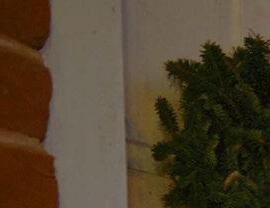





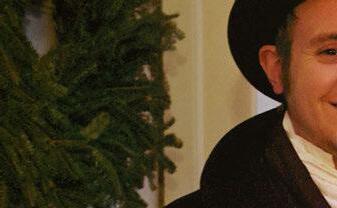



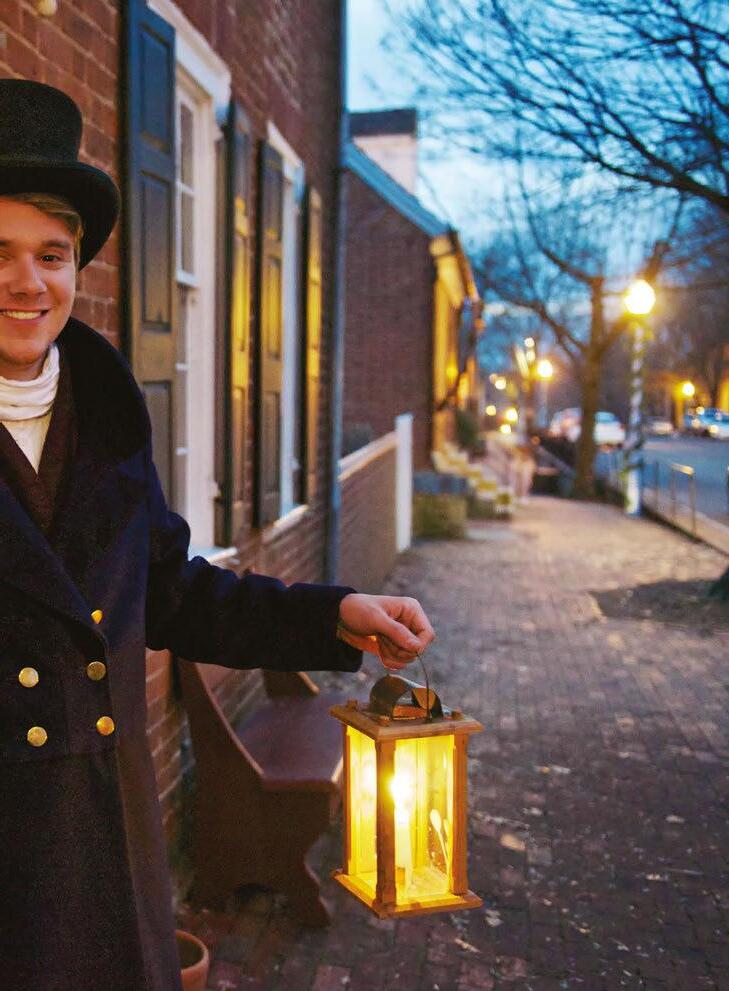
From the glow of gas lanterns to sweet Moravian sugarcake warmed by firelight, Winston-Salem o ff ers a whole new way to experience f season. Join costumed interpreters on a candlelit tour through 260-year-old homes festooned with original decorations. Enjoy cocoa and carols under a million twinkle lights. Or feast your eyes — and soul — on sweet Moravian delicacies you can only find here. So grab your keys. Reserve your favorite hotel.

Flying squirrels are rarely seen, but surprisingly abundantwords and photographs by MIKE DUNN
My first encounter with our local flying squirrels was on a cold December night years ago. I was sitting on the screen porch, sipping hot chocolate and enjoying the night sky, when I heard what sounded like birds chirping in the oak trees behind the house. The highpitched peeps seemed to move from tree to tree. I finally got a flashlight, shined it up into the treetops and spotted something as it swooped down to another tree and scurried out of sight. It didn’t flap like a bird or bat, but looked like a rocket-propelled kite angling downward through the trees — a flying squirrel!
I’ve probably had closer interactions with flying squirrels than most folks. I had the chance to interact with a captive one in programs when I first started working at the North Carolina Museum of Natural Sciences. The museum had obtained a flying squirrel that could not be released back into the wild from a rehab group. People loved seeing its big, adorable eyes up close, but it had maintained its nocturnal habits, so it spent most of its days sleeping in a special nest box in a cage. When I would gently get it out to show to an audience, it would often scurry into my sleeve or down the neck of my shirt to hide; then I had to squirm and reach until I could pull it back out. And those little claws are sharp!
Long before I heard the nocturnal squeaks off our deck, I had been taught by a naturalist friend to gently tap on hollow trees and nest boxes to see if “anyone” was home. If so, the occupant might poke its head out of the opening to see what the commotion was about. I have seen several species of birds (including various woodpeckers and screech owls) and some mammals (raccoons, squirrels and flying squirrels) with this technique.
Occasionally, flying squirrels will enter homes (usually the attic) and may need to be humanely transferred elsewhere. They generally cause no harm, but their nocturnal habits may create sounds that you don’t want. One night, a neighbor
in my old North Raleigh neighborhood heard something downstairs and went down to investigate, thinking it might be an intruder. As he entered the kitchen, he found the sounds were coming from inside a lower kitchen cabinet. Not sure what was going on, he bent down, flung open the door and was instantly hit in the chest by a flying squirrel! It quickly began jumping and running all over the first floor of his house. He called me and we finally herded it out the double doors into his back yard. We’re still not sure how it got in there.
There are two species of flying squirrels in North Carolina. The Southern Flying Squirrel is quite common and can be found statewide in pine and hardwood mixed forests. The other is the rare and federally endangered Carolina Northern Flying Squirrel, a subspecies of the Northern Flying Squirrel that is only found in the high-elevation forests of North Carolina, Tennessee and southwest Virginia.
Though not many people see them, Southern Flying Squirrels can be as abundant as the common Eastern Gray Squirrels we all know from our neighborhoods and local parks. They are the night shift in our woods. My trail cameras regularly catch them on the trunks of trees and occasionally on the ground, where they forage like their daytime cousins. Unless you hear them at night or see them at your bird feeders after dark, the best way to know you have them as neighbors is to look for the distinctive remains of their meals. Flying squirrels typically chew a neat round hole in hickory nuts or acorns to get at the tasty meat. If you look closely, you’ll see tiny teeth marks along the open edges and you may find a so-called carry notch, a little divot gnawed onto one end of the nut shell to make it easier to carry to a feeding


spot. By contrast, gray squirrels tend to shred the nut shell or crack it into several pieces. Chipmunks and mice can also chew holes in nuts, but a chipmunk leaves a more ragged edge and mice tend to make several small holes.
They accomplish “flight” by means of their patagium, a special fold of skin between the front and hind legs on each side of the diminutive mammal.
Of course, the defining characteristic of flying squirrels is in their somewhat misleading name. They don’t really fly, but they can glide distances of well over a hundred feet by means of their patagium, a special fold of skin between the front and hind legs on each side. This ability inspired the design of modern wingsuits used by human base jumpers and parachutists. When a flying squirrel climbs up a tree trunk and jumps off, it stretches out its legs and the patagia act as “wings” for it to glide; its tail also flattens. This gives the squirrel a great amount of surface area in relation to their size and weight (they weigh only about 2 to 3 ounces and are 8 to 9 inches
in length, including their 4-inch tail). Flying squirrels tend to have regular routes through their home turf, climbing multiple trees and gliding downward several times to get to prime feeding areas. They are able to turn in mid-glide at almost right angles by manipulating the patagium and tail. As they approach their landing, they pull upward, landing on the tree with all four feet. They then usually scramble around to the back side of the tree, possibly to avoid potential predators that may have spotted and followed them. Their main predators are various species of owls, foxes and domestic cats. If able to avoid predators and disease, flying squirrels can live five or more years in the wild.
One interesting tidbit about these wild neighbors was discovered in 2017. John Martin, a forestry professor in Wisconsin, was doing a nighttime survey of plants and lichens with a ultraviolet (UV) flashlight, since some species of plants fluoresce in UV light. He saw a streak of pink in his light beam and identified it as a flying squirrel. This prompted an extensive survey with fellow researchers of museum specimens and living flying squirrels. They found
that flying squirrels do, indeed, exhibit a pink fluorescence in UV light.
Ultraviolet fluorescence has been documented in plants, marine and terrestrial invertebrates, arachnids and birds. But it is rare in mammals. This group of scientists compared flying squirrels to other types of squirrels (including Eastern Gray Squirrels, Fox Squirrels and Red Squirrels) and found that only the nocturnal flying squirrels had the fluorescence. Interestingly, the only other local mammal that shows this trait is the Virginia Opossum. Why these critters exhibit this unusual attribute is unknown. Theories range from a form of communication between individuals in the forest to fooling predators. UV light is more important as sunlight is diminished at dusk and dawn and at night, so the ability to see and be seen in UV is more important to nocturnal animals. The fluorescence is brightest on the white fur on the belly and patagia. If an owl spots the bright UV streak of a flying squirrel as it glides to a tree, it may follow hoping for a meal. When the squirrel lands, the pink becomes harder to see, and then the potential prey darts to the other side of the tree to maybe live another day. (It turns out that several species of owls also have fluorescence on their belly feathers in UV, so who knows what may be going on in the evolutionary struggles of our forests.)
This past summer we participated in a museum-sponsored moth event at the house, where we put out a sheet with a UV light on the deck to attract and share our local insects. At one point, there were three flying squirrels on the nearby sunflower seed feeder, generally ignoring us. The feeder is on a pulley system, so we decided to pull the cuties closer to try to see the biofluorescence. Two of the flying squirrels didn’t like that plan and scrambled across the wire to the nearby tree. But one stayed and kept feeding until it was just a few feet from the deck. Shining a UV flashlight on it revealed the hot pink glow along the edges of its belly fur. Just another fun Friday night at home!

The life you’ve built deserves the community we’re building.
A luxury life plan community in one of Raleigh’s most sought-after locations, Hayes Barton Place is scheduled to open late 2024. Nearly seventy percent of the residences have been reserved, so now is the time to find out if this is the right plan for you!
to learn more.



Sri Lankipalli keeps traditions from her homeland alive with Earth Folk Apothecary
by ADDIE LADNER photography by LIZ CONDOAone-room wooden studio sits in the pine-filled backyard of Sri Lankipalli’s West Raleigh home. Here, floor-to-ceiling shelves hold vessels filled with dried rosebuds, hibiscus blossoms, wild turmeric and burdock root. A copper distiller sits on a counter; frankincense burns on an antique table. Light streams in from French doors and a brass Tibetan bell hangs on the wall.
In t his space Lankipalli pays homage to her homeland in
Southern India and the generations that came before her. When she was a child in the hillside town of Chittoor, her mother would rub a chalky clay native to the area on her belly when she had a stomach ache. Her grandmother would give her a spoonful of honey with black pepper to ease a sore throat. “I always felt better after these rituals. In India, we have a remedy for everything,” she laughs. Among them: ginger for nausea, peppermint for bloating, cumin for constipation, camphor for dry scalp.
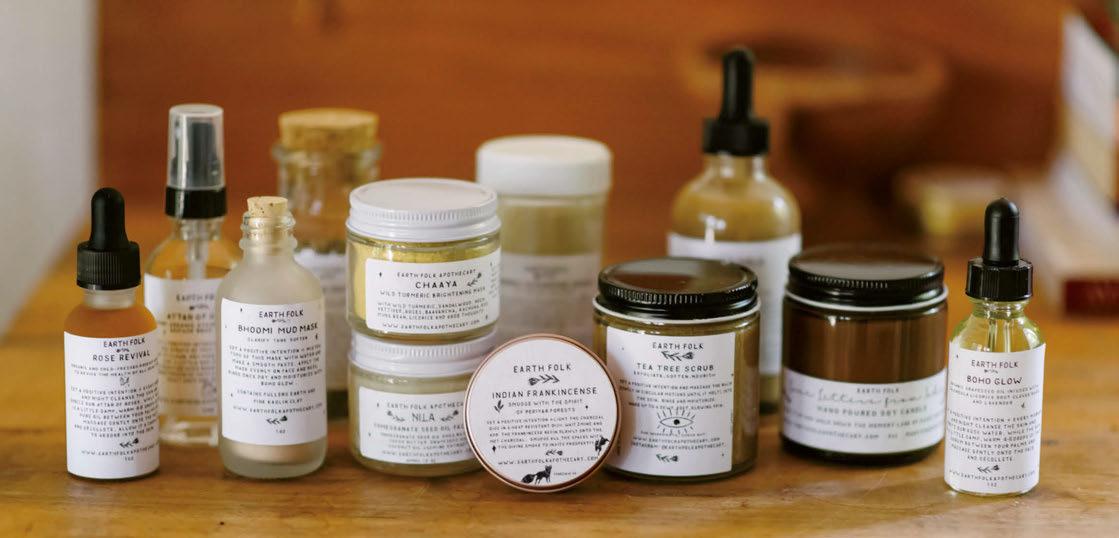
Such is the inspiration for Earth Folk Apothecary, a curated range of skincare products and teas that Lankipalli makes by hand. “My main focus is the very basics of skincare: cleansing, toning, moisturizing and masking. In my opinion, that’s all you need,” Lankipalli says. It’s all rooted in Ayurvedic techniques, an ancient form of holistic medicine and living centered around mindfulness, nature and viewing the body as an interconnected whole.
The Cleansing Grains is a gentle dry powder cleanser made from chickpea and rice flour with rose petals, turmeric and citrus. The Calming Potion is a tea of dried botanicals like lavender, St. John’s Wort and passion flowers. The Kesha Hair Oil combines ingredients like neem, curry leaves, eucalyptus, camphor, rose and lemongrass, all shipped to Lankipalli from her family back home.
Some of the items in her product range blend Western beauty rituals with Indian ingredients. The makeup remover, for example, is a product not often seen in India. “We don’t really wear makeup back home. When I started using lipstick when I first moved here in 2013, I posted a photo online and my mom freaked out! We believe you should embrace your imperfections and unique beauty,” she says. “But I try to blend my heritage with the culture here.”
To t hat end, the Cleansing Balm, a makeup remover, is made with calendula flowers, wild roses, shea butter and olive oil. Lankipalli melts the oils and butter together, steeps the liquid in the botanicals and lets it sit in a dark corner for four to six weeks, shaking it every so often. To get its thick, creamy consistency, she alternates whipping it by hand and refrigerat-
ing it over and over. “It inserts air into the butters, which helps it permeate into the layers of skin. Hand whipping, although arduous, produces a very rewarding texture,” she says.
She’s also enjoyed scouring the local markets for ingredients native to North Carolina. “I want to get more into biology and understand what’s native. Not everything that comes from India is beneficial to people who were born and raised here,” she says. “You need something that’s native to you.” She sources beeswax from local apiary Fruchtenicht Honey at the Durham Farmers’ Market and calendula from Cedar Grovebased herb grower Maple Spring Gardens. She also uses cedar bark from her backyard and “sometimes from my neighbor, who is kind enough to let me harvest from her gorgeous tree.”
While herbal remedies were always a part of her life, it was in eighth grade that the interest and awareness of her culture’s Ayurvedic practices took a stronger hold. Her parents, both knee-deep in their careers, worried she wasn’t getting the attention she needed and sent her to live with her grandparents for a year in a small village on the banks of the Krishna River. Her grandfather worked on nearby farms every day and her grandmother had a vibrant garden known for its fragrant roses. It was brimming with native plants like hibiscus and jasmine, as well as guava, neem, sapota and pomegranate trees that she tended to for hours every day. “It was a paradise of plants,” she recalls. “Neighbors and villagers would come to her home every day after she had harvested enough for her prayers and rituals, and she would happily let them pick what they wanted.”

You’re gonna need a bigger bag




Tomatoes, okra, basil, eggplant and other edibles supplied t heir kitchen. “I think that’s where this entire thing started,” she says. “Their needs were basic and their purpose was to be stewards to the land they were passed down. They were the Earth Folk to me. The original Earth Folk in my life.” Lankipalli would sit for hours watching her grandmother make a version of many of the remedies she makes today: “Some days I’d be intrigued to learn and some days it was just because there was nothing else to do.”
Once a month, her grandmother would harvest the neem, hibiscus, gooseberries, brahmi and bhringraj herbs, curry leaves and coconut oil from her grove and simmer them on a wood-fired stove to make hair oil. “My job was to occasionally go and stir the oil so the herbs did not settle at the bottom and burn,” she remembers. “She’d then let it cool and strain with an old soft cotton sari, squeeze out the oil and bottle them.” When she didn’t feel like exploring the garden or helping her grandmother, she’d tag along with her grandfather and uncle on the back of a bullock cart. “I watched both of them tend to the land in their own way with so much reverence and love,” she says. “There’s no way I’d ever know the names of any of the herbs that go into our natural bath and body products if it wasn’t for my year of that unasked apprenticeship with them.”
La nkipalli moved to the States in 2013 at 23 to get her master’s in information systems at Eastern Michigan University. But she kept hold of her family’s recipes for basic skin care. “It was a part of our everyday life, a normal thing,” she says, but out of a need to adjust to colder, dryer temperatures, she had to go a little deeper. “It was so cold. I needed something that would clean my face but not strip the natural oils,” she says. She tested a few different things, then started sharing them with friends and colleagues.
“I started selling them with encouragement from my friends; they loved my products and wanted to pay for them since they knew how expensive it was for my parents to ship
me the ingredients,” she says. As first-time customers became repeats, Lankipalli started selling at markets and online, and Earth Folk was created in 2016. “New customers are wonderful but it feels special when someone comes back because it worked,” she says. Karen Daidone, a Raleigh resident, switched to using Earth Folk products almost exclusively nearly two years ago and said she’s seen a dramatic change in her skin since. “My skin is somewhat oily and I have been prone to breakouts my entire life but these products have made such an improvement in my complexion. I can’t say enough good things about Earth Folk,” says Daidone. “I use the Cleansing Grains to exfoliate, Rose Water spray and Bojo Oil to moisturize in the morning. And the Cleansing Balm to remove makeup and Nila to moisturize before bed.”
her website and make an appointment to visit the shop. But Lankipalli doesn’t have any intention of it becoming a full-time job. Instead, it’s a meditative, creative outlet for her. “I love being able to use my hands and doing things like designing the labels,” she says. “It’s a nice balance to my day job.”
“My main focus is the very basics of skincare: cleansing, toning, moisturizing and masking. In my opinion, that’s all you need.”
La nkipalli and her husband moved to Raleigh in 2020, and she took a job at North Carolina State University as a business analyst. That year, they bought a house here and built the apothecary, which now drives a small but steady business. She opens her backyard studio twice a year, around the holidays and in the summer, and sells at markets in the Triangle. People can also order from
— Sri Lankipalli
And it’s an education. In the evenings and on the weekends, she’s usually delving into a stack of books on herbalism, Ayurvedic medicine and biology. “One day I’d love to learn how to make perfumes with hydrosols. I’m currently reading Braiding the Sweet Grass, Gaia’s Garden and Kitchen Garden Revival to help me plan a backyard garden where I can grow most of my own herbs for the apothecary,” she says.
But there’s a fundamental reason for keeping these ancient skincare rituals alive: “I cling to this because I am away from home,” she says. “As I grow older and farther from my family, memories become precious treasures. Those mundane days of my childhood have guided me toward a life I didn’t realize I had fallen in love with.”




Book in-person and virtual visits with providers who treat you right.
One Medical makes it easy to get primary care for your body and mind. Whether you visit us in our comfortable, modern offices or right from your phone, our providers and care team will make you feel seen, heard, and cared for.

Learn more at onemedical.com/WalterMag
Doctors on a first-name basis
Drop-in lab services
Dedicated member support
Next-day appointments
24/7 virtual care via message or video
Save $55 on your 1st year of membership. Use code: WalterMag


by
Give the gift of music for the holidays — and go the extra mile to make it a little piece of home, too. North Carolina has one of the most vibrant music scenes in America, much of it centered right here in the Triangle. Here are seven recent albums by locals to put under the tree.

ELECTRIC COWBOY: BORN IN CAROLINA MUD BY BOULEVARDS
All of Raleigh native Jamil “Boulevards” Rashad’s records have been excellent. But 2022’s Electric Cowboy: Born in Carolina Mud stands out — a wide-ranging set with pop and psychedelic flourishes alongside his deep-groove funk in songs like “Together,” “Time” and “God Bless Ya (Be Thankful).” It even has an unexpected guest, alternative-country siren Nikki Lane, who lends her voice to the song “Better Off Dead.”

A bona fide Raleigh institution, The Connells will mark 40 years of existence in 2024. And while they’re still making records, this one stands as their signature: 1993’s Ring, an unlikely overseas hit with the “’74-’75” single and video. That single was a top-10 hit in 10 different European countries, spawning a cult following that lingers to this day in the form of tribute video remakes. This year’s Ring reissue puts it on vinyl in America for the first time, with a CD version featuring a bonus disc of outtakes and demos.

The former frontman of Chapel Hill’s Flat Duo Jets, Dex Romweber is a local legend who ought to be a lot more famous beyond the Triangle than he is. But despite tastemakers like Jack White and Neko Case singing his praises, he
still toils in relative obscurity. To his credit, Romweber just keeps right on doing what he does so well. His latest album, Good THing Goin’, is another stellar roots-rock collection featuring songs by the likes of Las Vegas showman Engelbert Humperdinck, pianist Nina Simone and even German easylistening orchestra leader Bert Kaempfert. Somehow, he makes it all rock.

In many ways, DeYarmond Edison was the Triangle music scene’s equivalent to Buffalo Springfield, a 1960s-vintage country-rock band that launched multiple Hall of Fame careers. Transplanted from Wisconsin, DeYarmond Edison lasted about a year in North Carolina before imploding. After the group’s 2006 breakup, members went on to fame with groups like Bon Iver, Hiss Golden Messenger, Megafaun and Watchhouse. The tensions of clashing directions leading to DeYarmond Edison’s breakup are there to hear in the 83 tracks on seven discs of Epoch, a lavish box set. The package includes voluminous liner notes in the form of a 114-page book, written by former Indy Week music critic Grayson Haver Currin, who also served as executive producer.

BOOK OF FOOLS BY MIPSO
Mipso formed at the University of North Carolina at Chapel Hill in 2013, and the group started out with a sound close enough to bluegrass to hit No. 1 on Billboard’s bluegrass album chart a couple of times over the past decade. They’ve wandered far afield since then, from each other as well as stylistically, to the point that all four members put out solo releases this year before reconvening for Book of Fools, an album that bears no relation to bluegrass or even Americana. It’s atmospheric and highly sophisticated pop, especially Joseph Terrell’s guitar tones.

LIVE AT BOND BROTHERS EASTSIDE, VOL 1 BY PETER LAMB AND THE WOLVES
Raleigh may be the City of Oaks, but it feels a lot like New Orleans whenever and wherever Peter Lamb and the Wolves fire it up. A fine ensemble of local jazz veterans, Lamb and company

have been working their magic for years, developing a particular affinity for cutting hot live albums in local eateries. After 2013’s Humble Pie (recorded at the late, lamented downtown Raleigh restaurant) comes an album made at Cary’s Bond Brothers Beer Company that covers a lot of ground: swinging renditions of songs by Cole Porter, The Meters, Randy Newman and more, with the album-closing cover of the Lead Belly classic “Where Did You Sleep Last Night?” as a cherry on top.

A veteran of the Deep Gap bluegrass ensemble Cane Mill Road, Raleigh banjo player Tray Wellington has always been a musical polyglot. He’s the sort of bluegrass player who can cover fashion-plate rapper Kid Cudi’s “Pursuit of Happiness,” and in his hands it makes perfect sense. Wellington’s 2022 album Black Banjo adroitly threads the needle between Béla Fleck’s eclectic worldliness and Kruger Brothers’ old-world classical bluegrass, with the historical smarts of Rhiannon Giddens.

The Raleigh Police Department Foundation is dedicated to the mission of the Raleigh Police Department to make Raleigh the safest city in America. We help assure safer neighborhoods by providing education, technology, and program support to our police officers. For more information on how you can help, visit raleighpolicefoundation.org








It’s party season! From holiday potlucks to cocktail soirées, there’s lots going on. Stuck in a rut on what to bring? We asked the experts — aka, local caterers — for their go-tos when they’re heading to or hosting a holiday party. From bite-sized treats to crowd-pleasing entrees, these dishes are sure to be a hit.
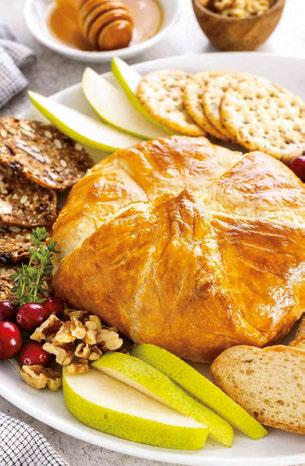
JILL DONOVAN OWNER
DONOVAN’S DISH CATERING
“Who doesn’t love a delicious baked brie?” says Donovan. “This dish is fresh, seasonal, decadent and a huge crowd pleaser!”
INGREDIENTS
6 ounces (one wheel) brie cheese
4 ounces chutney (Donovan loves Mrs. Ruth’s Appley Dappley)
1/2 sheet of puff pastry
1 egg
Fresh baguette, sliced Granny Smith apple or fancy crackers for serving
DIRECTIONS
Remove rind and cut brie horizontally into three equal parts. Place brie on top of the puff pastry. Spoon chutney between each layer of brie, as well as on top. Fold pastry from corner to middle until all four corners are in the middle, flatten pastry and flip over. Bake at 350 degrees for 35 to 40 minutes or until golden brown. Serve warm with Granny Smith apple and a fresh baguette.
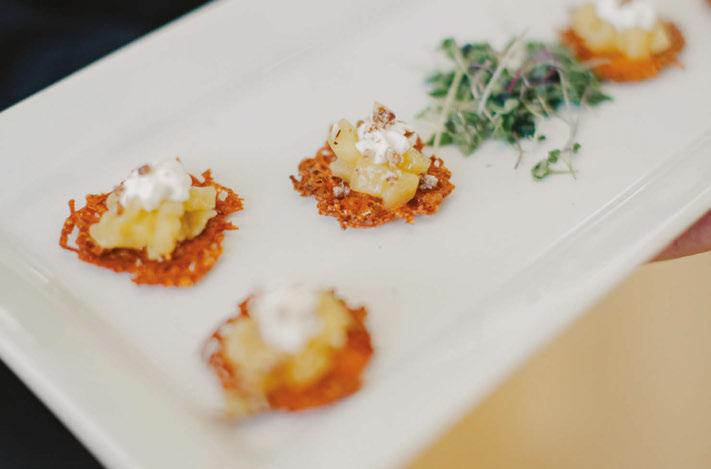
JILL SANTA LUCIA CULINARY DIRECTOR CATERING WORKS
“I love making any kind of bite-sized appetizer that has a play on fruit and cheese,” says Santa Lucia. “This recipe is fast, easy and a crowd-pleaser. I can make all the components ahead of time and whip it together right before a party. It’s also gluten free, small and has a sweet and savory component.”
Ken Irwin and Marian Leighton selling albums.
CHEDDAR CRISPS
INGREDIENTS
6 cups cheddar cheese, grated (Santa Lucia uses Ashe County Hoop Cheddar)
1/4 teaspoon cayenne pepper
1/4 teaspoon Kosher salt
DIRECTIONS
Preheat the oven to 425 degrees. Top a cookie sheet with parchment paper. Drop grated cheese onto parchment paper, 1 tablespoon at a time. Spread each drop into an even layer and space about 1 inch apart. Sprinkle the cheese with cayenne pepper. Bake for 6 to 10 minutes; you want the cheese
to melt and stop bubbling, but don’t let it get brown. Remove from the baking sheet and cool until ready to use. (Yields about 48 crisps.)
APPLE TOPPING
INGREDIENTS
1/4 cup unsalted butter
1 cup light brown sugar
1 1/2 pound Honeycrisp or Granny Smith apples, peeled and diced
1/4 teaspoon cinnamon
Salt, to taste
1 cup nuts, toasted (Santa Lucia prefers pecan pieces)
1/4 quart whipped cream
DIRECTIONS
Peel and finely dice the apples. In a sauté pan, melt butter, add in sugar and apples, and cook until apples are soft. Sprinkle a little cinnamon and salt into the mix.
TO SERVE
Top each crisp with apple filling, toasted nuts and tiny rosette of whipped cream.
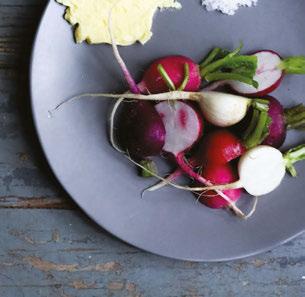 JACOB BOEHM EXECUTIVE CHEF & OWNER
JACOB BOEHM EXECUTIVE CHEF & OWNER
SNAP PEA CATERING
Boehm keeps it simple when he’s heading to a party. “I love to surprise folks by bringing a simple platter of gorgeous radishes, with the very best butter (softened, of course) and flaky salt. It’s crisp and refreshing, while still feeling elevated and indulgent. It might sound odd, but trust me — it’ll be the hit of the party!” Boehm gets Easter egg radishes from Transplanting Traditions Community Farm, makes butter from raw milk cream from Lilly Den Farm (“It’s easier than you think!” he says), and pairs them with North Carolina-sourced salt from Hatteras Saltworks.
INGREDIENTS
Local Easter egg or watermelon radishes
Good quality butter
Flaky sea salt
DIRECTIONS
Bring butter to room temperature. Meanwhile, slice radishes into medallions or, for smaller ones, halve longways. Arrange the radishes, a large dollop of butter and a pile of salt on a platter and serve.

BRUCE DAVIS FOOD & BEVERAGE EXECUTIVE DIRECTOR, ON BOARD HOSPITALITY MANAGEMENT GROUP
“This is one of my favorite and most popular dishes to bring to a holiday party,” says Davis. “It is a simple but sophisticated dish that tells your guests you know what you are doing in the kitchen.”
SHRIMP INGREDIENTS
1 1/2 pounds jumbo shrimp (21/25 count), peeled, deveined and thawed
Ken Irwin and Marian Leighton selling albums.
1 teaspoon Old Bay seasoning
2 unsalted butter
1 bunch scallions, thinly sliced, light and dark green parts divided
1 large stalk celery, finely diced
1 tablespoon onion powder
1 tablespoon garlic powder
2 tablespoons flour
1 tablespoon Knorr chicken base
4 cups whole or 2% milk
1/2 teaspoon hot sauce, such as Tabasco
Salt and pepper, to taste
1 cup of heavy cream
1 cup quick-cooking grits
3/4 cup cheddar cheese, grated
1/4 cup parmesan cheese, grated
1/4 cup Monterey Jack cheese, grated
Start the shrimp: Heat a large nonstick skillet over medium heat. Add the shrimp to the skillet and sprinkle with Old Bay. Increase the heat to mediumhigh and cook, stirring occasionally, until the shrimp are mostly pink but not quite cooked through, about 2 minutes. Pour into a bowl to reserve during the next two steps.
Melt the butter in the skillet. Add the scallions, celery, onion powder and garlic powder and cook, stirring occasionally, until the vegetables soften, about 4 minutes. Sprinkle in the flour and mix until incorporated. Whisk in chicken base, milk and hot sauce and bring to a boil. Reduce the heat and simmer, uncovered, until slightly thickened, 5 to 7 minutes. Remove the skillet from the heat and set aside while you make the grits.
Make the grits: In a medium saucepan set over medium heat, bring the heavy cream and salt to a boil. Whisking constantly, slowly pour in the grits. Reduce the heat to low and simmer, stirring continuously, until the grits become thick and creamy, about 5 minutes. Remove the pan from the heat and stir in the cheeses. Cover with a lid to keep warm until ready to serve.
Place the skillet with the vegetable/ sauce mixture back on the stove and bring to a simmer over medium heat. Add the reserved shrimp, along with any juices that collected in the bowl, to the skillet and mix well. Cook, stirring frequently, until the shrimp are cooked through, 2 to 3 minutes. Season to taste with salt and pepper. Sprinkle a handful of the dark green scallions over the shrimp (you may not need all of them).
To serve, ladle grits into a bowl and top with the shrimp-vegetable mixture.

COLEEN SPEAKS OWNER, POSHNOSH CATERING
“Oysters are such a fun party food,” says Speaks. “This is my elevated take on the emergency pantry go-to of tinned oysters. I start with fresh shucked oysters, brine them for 48 hours, hot-smoke them and then marinate with lemon zest, olive oil and crushed red pepper.”
INGREDIENTS
1/4 cup kosher salt
1/3 cup brown sugar
1/4 cup soy sauce
1 bay leaf
1 teaspoon hot garlic powder
1 teaspoon hot onion powder
1 teaspoon hot black pepper
1/4 cup bourbon
A couple dashes of hot sauce
1/3 cup water
1 pint of NC select shucked oysters
3/4 cup olive oil
1/4 teaspoon crushed red pepper flakes
Zest of 1 lemon
Salt and pepper to taste
Horseradish cream, pickled red onions and fried saltine crackers
Create the brine: Combine the salt, brown sugar, soy sauce, bay leaf, garlic powder, onion powder, pepper, bourbon, hot sauce and water in a saucepan. Bring to a boil and stir until sugar and salt are dissolved. Let cool completely.
Once cooled, add the oysters to the brine, making sure to stir them to separate. Refrigerate for at least 24 hours and up to 48 hours (the longer the better).
Heat a smoker up to 225 degrees. Drain oysters from brine (you can save it for another batch). Spray a wire rack with non-stick spray and place it over a pan that can fit on your grill. Place oysters onto the rack in a single layer, then place the pan onto the grill of the smoker.
Smoke the oysters for 45 minutes to 1 hour, checking and rotating halfway through. (A properly smoked oyster is plump, curled around the edges, and shrunken about 25%.) Remove from smoker.
Place smoked oysters in a jar and cover with olive oil, red pepper flakes, lemon zest and salt and pepper. Make sure oysters are submerged in oil until ready to serve.
Serve with horseradish cream, pickled red onions and fried saltines.
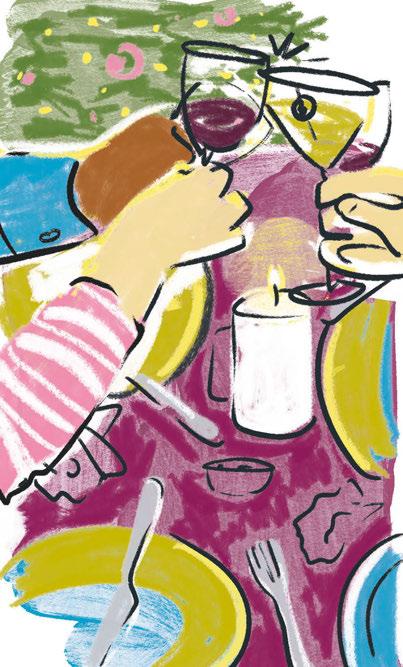




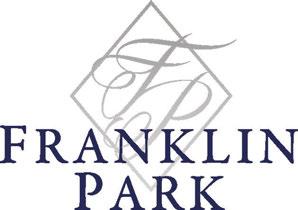









Cary, NC
Experience MOVE-IN ready, luxury single- oor living with Deluxe Amenities! is brand-new community is perfect for busy professionals or those looking for a luxury living space with less maintenance. e property o ers a hospitality suite, exercise room with equipment, pool & clubhouse, tennis & volleyball courts, kids park, lake & walking trails, garage parking, and extra storage rooms. Franklin Park Condos is within walking distance of endless shopping, grocery stores, and restaurants in the booming Cary area.
•3 Beds
•2.5 Baths
•Elevator
•Garage
•Covered Porch
•Walking Trails
•Extra Storage
• 2,301 - 2,381 Sq Ft
•O ce
•Exercise Room
•Pool
•Lake Access
•Clubhouse
•Tennis/Volleyball Courts

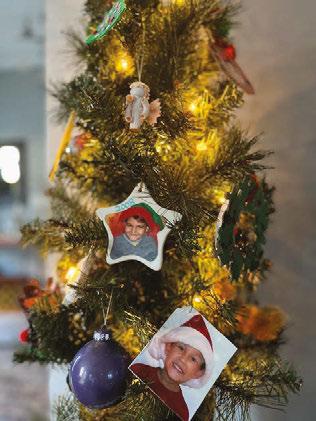

The author’s family at the holidays.

In 1996, I was recently divorced and staying put for Christmas — no in-laws to visit, no family in town. And, truth be told, I felt like a failure and was too ashamed to go home for the holidays. I found myself alone in a one-bedroom apartment with outdated carpeting, a lousy view of a parking lot and a tired kitchen.
I’d married young and never lived alone, so this was my first taste of independence, as well as my first taste of real loneliness. The weather outside was frightful (it was December in Minneapolis), but there was still something festive in the air among the shop window lights. So I made a conscious decision not to wallow: I bought Neil Diamond’s The Christmas Album CD, hauled up a tree,
cobbled together some decorations and bought herringbone crystal cocktail glasses. Instead of throwing a pity party, I threw a Christmas Eve party for myself and a few fellow holiday “orphans.”
This year marks the 25th year of that party (alas, we lost two years to Covid). I got remarried in 2000, and the tradition carried on as part of our new life together. What started as a slightly awkward gathering of misfits has evolved to become a beloved (and slightly boisterous) family tradition. The party has followed us across all the places we’ve called home over the years: Madison, Wisconsin; Chicago, Illinois; and three homes in Raleigh in the two-plus decades we’ve lived here. We host the party as a come-as-you-are open house, offering a feast that features
local delicacies. (We have been known to drive over an hour to Garland to pick up barbecue and bacon jam from Matt Register’s Southern Smoke.) There’s a tower of to-go boxes at the ready for guests to take home leftovers. We’ve experimented with a champagne bar and whiskey bar, both big hits.
These days, the Ewen Christmas Eve Soirée often includes more than 100 guests — neighbors, friends, colleagues and anyone they want to bring along. It’s a multigenerational sight to behold. Guests who first arrived as squirming babies with bottles, mystified by twinkling lights, are now young adults, old enough to uncork bottles and pay their own taxes. My sons’ friends inquire about Christmas Eve so they can work their
plans around the party hours. Their families are invited too, and it’s been a lovely way to meet their parents, such a challenge after the elementary-school years. New friends join us with young children; they play with the LEGOs and Playmobil sets I cannot bring myself to donate. (There’s something about Christmas that brings out the little kid in our big kids — we often spot them cross-legged on the ground with LEGOs, too.)
The passing of time means we have also mourned friends who have passed. Each year, there seems to be someone special gone from the table as we juggle these sandwich generation years. But it’s always a wonderful sentiment when a friend comes to the Christmas Eve party for the first time after losing a loved one and thanks us for always including them.
Many years ago, after sifting through a mantel full of wine bottles and hostess gifts, my husband Todd said, “We don’t need all this. Why don’t we ask our friends to donate something instead?” And so a new tradition was born: in lieu of a host gift, we ask guests to support the Diaper Bank.
Now, the weeks leading up to the party means an almost daily delivery
of diapers and wipes. We literally fill my husband’s home office with these much-needed supplies; the season is a time for giving, and it did, after all, start with the birth of a baby.
This year marks our first holiday season as true empty nesters, so the prep will be on our shoulders as we eagerly anticipate our sons coming home from the University of Wisconsin and the Univer-
This year, we are asking Santa for a better final-exam schedule.
Remarkably, we have very few photos of 25 years of parties. I take it as a testament to the spirit of the gathering, a rare time people don’t stare at a phone in hand. Instead, we have stories: Once, the whole toilet paper holder was ripped off the powder room wall (no one ever did ‘fess up), and there was the time kids were
What started as a slightly awkward gathering of misfits has evolved to become a beloved (and slightly boisterous) family tradition.
sity of Oregon. Our older son, Carter, almost missed the party last year due to a combination of a late exam, bad weather and a spate of air travel nightmares. We all had our phones and laptops hard at work, refreshing apps and clicking away at keyboards to find a way to get him home. We managed to get Carter rerouted to Charlotte, to which my husband drove in the wee hours to pick him up. After a power nap and scrounging for party-ready clothes (his lost luggage arrived five days later), Carter opened the door to our first guests of the evening.


using wrapping-paper tubes as light sabers and, in the tussle, ended up busting a giant hole in the playroom wall.
The lonely young woman I was in 1996 could have never imagined the abundance that would come in the 25 Christmas Eves after. Each year, as we toss off our shoes and start the massive cleanup, we marvel at seeing people we adore coming together, laughing until our cheeks hurt and having conversations that offer new perspectives. And I still have those cocktail glasses.


It’s December and, without fail, I’m thinking about snow.
Thanks to Bing Crosby and Irving Berlin’s Oscar-winning song from the 1942 musical film Holiday Inn, the idea of a “White Christmas” is deeply ingrained in the psyche of anyone who loves the holidays.
I’m no different. I dig everything about Christmas, from the ancient story of a savior’s birth to the faux snow of sappy Hallmark holiday movies.
But my love affair with the white stuff goes much deeper than that.
My first taste of snow came in South Carolina in 1959, where my dad worked for a year at a small-town newspaper.
Shortly before Christmas, a freak snowstorm shut down the entire town for a couple days.
My mother, who grew up in the Allegheny Mountains of western Maryland, where it snowed heavily every winter, allowed me and my brother to take a large antique serving tray to the nearby golf course, where we would slide down the hill along with every kid in town. Everywhere we looked, snowballs flew through the air and snow angels spread their wings. The snow barely lasted a day, but it was nothing short of magical to this wide-eyed kid of 6.
Better yet, we spent that New Year (and many thereafter) in snowy Cum-
berland, among my mother’s people, a wintry clan of big, blond German aunts and uncles who celebrated the season with roaring fires and lively gatherings. I remember going outside during a rowdy family New Year’s Eve party just to stand in the knee-deep snow outside my Aunt Fanny’s house, marveling at the beauty and still silence of the falling snow.
Not long after we moved to Greensboro in January 1960, it snowed there, too. My dad took me to Western Auto and bought me a Flexible Flyer sled. Our hilly neighborhood street got blocked off and briefly turned into a miniature bobsled run.
In those days, it seemed to snow at least
two or three times every winter across North Carolina’s Piedmont. This fact was confirmed at my recent 50th high school reunion, where the shared memory of several deep snows during the 1960s and ’70s seemed to be a popular topic of discussion. “I remember how exciting it was to go to bed when a snowstorm was predicted,” said my friend Cindy. “Waking up to find it had snowed and school was canceled was like Christmas morning all over again.”
It was during those years that I made a silent vow to someday live in snow country. This idea was probably put into my head by my English teacher, Miss Elizabeth Smith, who gave me the Collected Poems of Robert Frost. The poet’s very name said winter, and his words whispered to me like a siren call: Whose woods these are I think I know / His house is in the village though / He will not see me stopping here / To watch his woods fill up with snow. Someday, I told myself, that fellow will be me.
After six years in Atlanta working for the Atlanta Journal-Constitution, I took a job as with Yankee Magazine, moving to a bend of the Green River outside of Brattleboro, Vermont. The snow was already falling when I got there in late November 1983, taking possession of a tidy two-room cabin heated only by a wood stove. I promptly got myself a retriever pup from the Windham County Humane Society and spent a glorious winter reading every poem, philosopher and piece of literature I could lay hands on. Walking with my dog in the blue dusk of an arctic evening, I came to love the brilliance of the winter stars and finally got to see the Northern lights.
It was the most solitary and wonderful winter of my life.
No surprise, I suppose, that my first wife and I eventually built a house on a forested hilltop near the coast of Maine and raised our babies there. My daughter Maggie was born at dawn after an overnight blizzard. I remember driving home to feed the dogs at our cottage on Bailey Island as the sun came out, illuminating a world made pure and peaceful by blan-
kets of snow. I’d never been happier.
On particularly clear and frigid nights, I would put on my red wool jacket and tote a bag of sorghum pellets to the edge of the forest, where a family of whitetail deer and other forest creatures could often be seen feeding in the moonlight. That became the source of many bedtime stories I made up for my young adventurers. They still mention those silly winter tales to this day.
One year, however, there was no snow on the ground right up to Christmas Eve. Our Episcopal church decided to hold its evening service in a nearby barn. Maggie and her brother Jack played a sheep and a cow, respectively, in the annual Christmas pageant and I was asked to bring along my guitar and play “Silent Night” to conclude the service.
A large crowd in parkas and snowsuits turned out to fill the barn, shivering among the sheep pens as the ancient story of a savior’s birth was retold. At one point Maggie asked with a whisper if I thought it might snow that night. I assured her it probably would because Santa needed snow for his sleigh.
The candles were lit and I played the beloved Christmas hymn. And as we all huddled together with the barn door firmly shut against a sharp northern wind, a Christmas miracle of sorts took place outside.
When the doors opened and we all filed out, pausing to exchange hugs and wish each other “Merry Christmas,” someone suddenly cried with a voice of pure childlike wonder: “Oh, look . . . it’s snowing!”
Indeed it was — big, dreamy flakes floating down as if on cue from either Bing Crosby or Heaven itself, like an answered prayer.
Whichever it was, by the time we reached our wooded hilltop, the world was pure white and the night was very silent indeed. We woke to 2 feet of fresh snow the next morning.
No Christmas since has come without remembering that magical evening.
And that’s why I still hold out hope for snow every December.




























Like the draft of a sentimental poem, Christmas arrives every year, every year with crazed couplets of family and home, to fill us with something mistaken for cheer.
We doggedly go from store to store always afraid somehow we will fail. The message of Christmas — buy more, buy more, family affection — reduced for quick sale.
It’s as if we are running for a train, we know we will miss, but what if, what if We put an end to this holiday pain, And stop searching for hope in expensive gifts.
Could we find a holiday we’ve long neglected, and even the gift we least expected?
Carrboro-based Susan Willey Spait has been published in numerous anthologies. Naked Ladies Bloom in Autumn (Plan B Press) is her second chapbook. In 2023, she published Pandemic Diaries (Sable Books), her first long poem.


Each year, an all-volunteer crew decorates from top to bottom

When it comes to Christmas bedecking, there’s the Biltmore Estate, there’s Dollywood and there’s the Angus Barn.
Even Scrooge would catch his breath in the iconic Raleigh steakhouse’s fantastical holiday display of thousands of lights, ornaments, legions of nutcrackers and reindeer.
Angus Barn owner Van Eure and her dedicated team of volunteer decorators unleash the ladders and LEDs in early October. Each year, they reach new heights in bringing the Christmas cheer (literally: there’s now a 40-foot flagpoleturned-tree out front).
Each room in the restaurant, from the Wine Cellar to the Wild Turkey Lounge, has its own decorative holiday theme, with the main dining room always adorned in traditional red and green, in a display that garners as much attention as the Angus Barn’s award-winning food and wine selections.
“For many families, dining at the Angus Barn at Christmas is a tradition across generations," says Eure. “We want to make
sure it’s an unforgettable memory.”
She a nd her team erect scaffolding inside and aerial work platforms outside the restaurant, hanging lengths of garland, giant peppermint candies, stockings, wreaths and ribbons galore. Decorations are kept as high as possible, so as not to encroach on the prime table space, which accommodates some 800 diners at a time.
It wa s 20 years ago, at her sister Shelley’s urging after a visit to The Greenbrier, that Eure began decking the barn out for Christmas. In the early days, the staff assisted with decorating, arriving early in the mornings to hang candy canes and bells and serving food as usual at night.
Then, about eight years ago, one of Eure’s neighbors, Kate Parke, stopped her in the street and said she wanted to help. Parke had a crew of church friends whose children all attended preschool together, freeing up their mornings. “I love Christmas and I like to decorate, so I knew we’d be good at this,” says Parke, who has a knack for channeling passion into productivity. She and her eight friends became the initial vol-

The copious decorations are hung high overhead, to not interfere with dining.
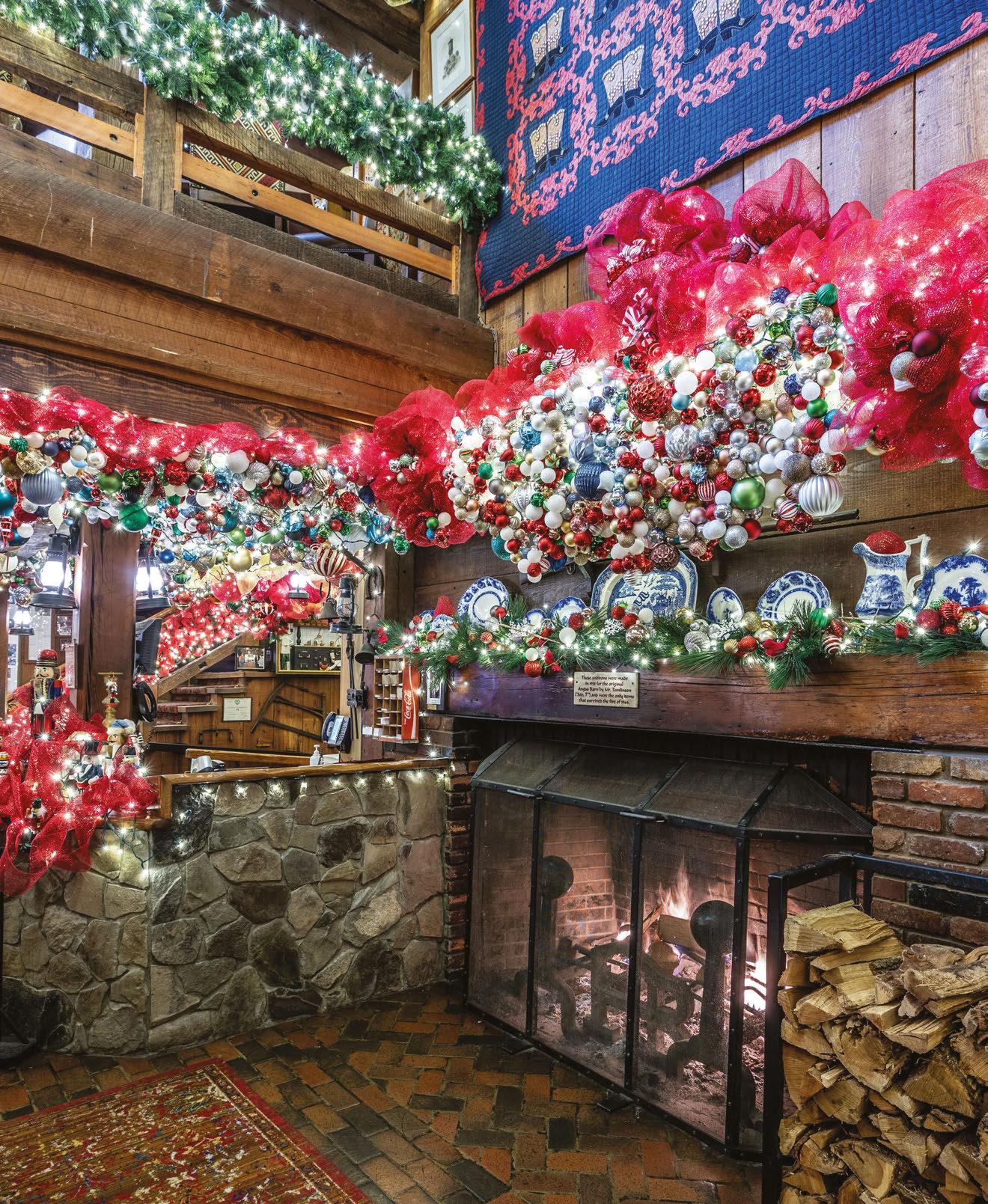
The entrance sets the scene with thousands of baubles, plus dozens of nutcrackers.

unteer crew, donning pink t-shirts that read, The Real Housewives of Angus Barn
Undaunted by the physicality of the work, the way it is tough on the hands and sometimes the heart (garlands fall, lifts threaten to tip, lights go out), the volunteers set to work hanging the tens of thousands of ornaments on the ceiling of the entrance. “We got it done,” says Parke, “and we never looked back.”
Some rooms are white and snowy, others glittering gold — all together it is a wonderland of splendor.
Now there’s a sign-up limiting eager volunteers to 20 per day. Parke is at the barn from 8 a.m. to 3 p.m. five days a week starting in September. This year, they’re sporting Angus Barn Christmas Crew hoodies for what has become a cherished ritual: spending their fall mornings listening to classic rock (Eure’s choice) while assembling a
Christmas locomotive, setting up two new animated reindeer at the front door and tucking in final touches like snowy owls and snowflakes into the garland. Parke also makes around 50 trips per season to Michael’s for decorations, where she’s been known to bring some cheese and crackers or pie to a patient check-out clerk.
Eu re and her team are always adding more to every room, but the kitchen will be missing one important element this year: chef Walter Royal, who passed away unexpectedly in May after 27 years as head chef at the Angus Barn. The jacket Royal wore when he won Food Network’s Iron Chef America is now framed, hanging above the table that was “his” for years.
“Walter was a force, and losing him is a horrible blow,” says



The decorations continue upstairs to the
and through every dining space.




Some spaces stick to a white-and-gold scheme.

Eure, “but the cooks are proud to be able to say that because of Walter, because of how well he trained them, the Angus Barn is going to be okay.” New head chef Scott James, who worked with Royal for nine years, this year saddles up for his first Christmas at the barn, serving up classics like the bone-in Royal ribeye and BBQ pork ribs to families who have often waited all year to dine beneath shimmering garlands.
The most popular holiday time slots at the Angus Barn fill up a year in advance — some patrons book the next year’s table on their way out the door. (Reservations have even been seen for resale on Facebook Marketplace.) In December, the kitchen churns out 2,000 gingerbread cookies a day, handed out by elves to patrons as they exit.
When Eure’s father, Thad Eure, Jr., opened the Angus Barn with business partner Charles Winston in 1960, critics doubted the potential of a restaurant situated so far from civilization, halfway to Durham on the two-lane Highway 70, where there wasn’t much beyond a pay phone every few miles. RDU Airport and Research Triangle Park were new, but before
long, people needed access to both, and the Angus Barn was no longer in the middle of nowhere. Now, the big red barn is an icon, especially when lit with hundreds of thousands of lights, edging the rooftop, the trees and the famous windmill out front.
Some rooms are white and snowy, others glittering gold — all together it is a wonderland of splendor. Many of the lights now stay up all year, only to be turned on at Christmas. But in the second week of January, all the other decorations — ornaments, ribbons, nutcrackers, wreaths — are carefully taken down by the same loyal team that puts it all up. The decorations are tucked into labeled boxes and stored until the next fall, when Eure will be back tying bows and traversing the scaffolding, leaning from the rafters to ask someone to toss her up another little artificial silver tree.
“Life is full of challenges,” Eure says, “but at Christmas, when people walk through the doors of the barn, I only want them to feel magic.”
Areli Barrera Grodski and Leon Grodski Barrera
brew conscious spaces for community




Areli Barrera Grodski is standing in a glass-walled section of her coffee shop, Cocoa Cinnamon, where the roasting department of her coffee company, Little Waves, churns out 1,800 pounds of coffee a week. Longtime employee Pin Brent, who’s just as adept at brewing an espresso as roasting a batch, jumps between monitoring a roast of Ethiopian Yirgacheffe and loading another bin of beans for the next round. The shelves behind Grodski are stuffed full of orders from their online business, with beans headed for customers in New York, Illinois, Kentucky, Michigan and Washington state.
“This is the phase in which you start creating body and some of those sugar browning notes,” Grodski says over the din of the roasting machine. “Once the development happens, that’s when a lot of those acids that are already part of the bean start to come out. The longer you take it into the roast, the more of those you get rid of.”
She pulls a small cylinder full of beans out of the roaster’s front, careful to pick up any bean that falls out in the process. She explains that these beans are in the phase known as “first crack,” when the hull of the bean splits as its chemical compounds start evolving. “That’s the pressure coming out,” she says, pointing to the beans. “So now go ahead and sniff it — it smells a little bit like vinegar.”
Vinegar is not a flavor anyone wants in their morning coffee; it’s just a step on the way to the deeper qualities. Grodski and her team are adept at pulling a plethora of notes from a wide variety of beans harvested from producers in Peru, Brazil, Rwanda, Ethiopia, Nicaragua, El Salvador, Mexico and Colombia. Some of the coffees they offer are blends, like the Positive Pressure espresso (a “nutella, madagascar vanilla and cherry” combination from Mexico and Ethiopia), while others have intricate tasting notes, like the Edwin Enrique Noreña Pink Bourbon, from Colombia, which is described as “grape juice, guava, raspberry, gummy
bears, in a bright, unique and juicy cup.” It’s a wild coffee, with those flavors attributed to the beans’ fermentation process, which includes submerging them in a tank with grapes, figs and prunes. Their skills have not gone unnoticed: in 2022, Little Waves won Roast magazine’s microroaster of the year award. Their beans can be found at Heirloom Brewshop, NOFO @ the Pig and Rebus Works, along with grocers Weaver Street Market and Whole Foods. And their three Cocoa Cinnamon locations in Durham are routinely packed with patrons working on laptops, reading or deep in conversation.

The current operation is a far cry from a decade ago, when Grodski and her husband, Leon Grodski Barrera (the two took each other’s surnames) were pedaling a three-speed bike full of beans, grinders and immersion brewers around downtown. “Durham doesn’t seem hilly until you put a 400-pound espresso machine on a bike,” laughs Barrera. “I have every ridge memorized in my body.

We would take really long routes just to not have to go up and down hills.”
The couple moved to Durham from Cherokee, a small town on tribal land in Western North Carolina where Barrera ran a coffee shop slash art space called Qualla Java that was a central part of the community. He had been a multimedia artist in New York City for years, and while working in 2001 on a project that got installed at the old CAM in Raleigh, he got to know this artistic community in the state. He became a resident artist at Western Carolina University a couple years later, and then ended up in living in Cherokee through a relationship with someone who was a member of the tribe.
Grodski was born in Mexico but moved to the United States when she was 6 and grew up in Cherokee. She attended the University of North Carolina at Chapel Hill but returned after graduation in 2009. They’d known each other for several years, but fell in love after she was back in town and were married in 2010. On their honeymoon, the couple was sitting at a café in Verona, Italy, discussing their plans. They knew they wanted to start a business, and they both saw how important and vital Qualla had been to the Cherokee community.
“When it’s a small town, it’s usually just like, sports, church, gathering in parking lots,” Grodski says. “So it was really nice to see how it could create space for community. And that was something that really inspired me.”
Part of Grodski’s studies at UNC involved Indigenous literature from Latin America, which resonated with the experience of living in Cherokee — and the parallels between each place’s struggles under colonialism. Coffee, she says, “was the vehicle for that.”
“I feel like coffee has all of these different dimensions of understanding the world, understanding yourself, how you show up in community, how you dial in that espresso, how you source beans,” Grodski says. “When you are creating a business that is so centered on community, you have to recognize how you are as a person and how you show up — how

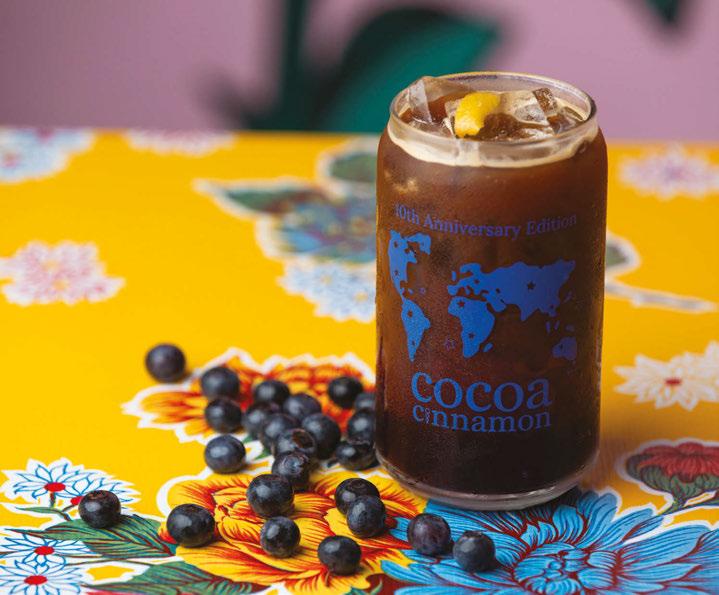
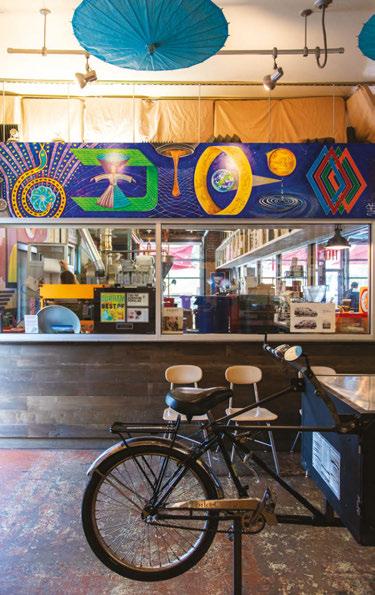
you react to different, especially really hard, situations in a community. And how societal ills will show up at your front door.”
Durham made sense for creating such a space. In 2010, the city’s downtown was just at the start of the transformation into the bustling hub of commerce that it is today, and the couple saw an opportunity to create the type of café in Durham that Qualla was for Cherokee. So they started running a business off of that converted bicycle, pedaling between farmer’s markets and events in Durham at places like Scrap Exchange and Motorco. They’d wanted to have an “espresso bike,” but gravity had other plans.
“As we were building it, Leon rode it without anything on it, and he was like, there’s just no way we can add any more weight to this,” laughs Grodski. So they settled on using immersion blenders called Clevers — a four-minute brew — but then the weather foiled them.
“I was outside Motoroco till one o’clock
in the morning and that night it was like 19 degrees,” says Barrera. “I’m sitting there with Clevers and all of a sudden you can’t brew coffee at 19 degrees if you’re letting it sit there for four minutes.” They pivoted the business plan to use Aeropresses: vacuum-press devices that make a strong, espresso-type cup. It was a more resilient way to do an outdoor café with the bike, but it was also very labor-intensive, as the “press” part of the Aeropress requires a lot of elbow grease and timing. (They also only used hand grinders since they couldn’t lug a lot of electricity around on the bike.)
“It was a lot of hard work — but was also really beautiful,” says Barrera. “We would set up at the Hunt Street Farmer’s Market and people would stand in line just to be social. It took forever, but we would just have a line across the street, and it would just be brewing three at a time on Aeropresses — just busting our butts.”
By 2013, the couple had established a name for themselves in Durham with a
better understanding of the community and the market. A brick-and-mortar location made the most sense, and there was an ideal location on Geer Street, near Motorco and Fullsteam Brewery. But they only had $75 and zero credit.
The person who owned the building, Bob Chapman, had fielded business plans from more than a dozen people who wanted to open a coffee shop in the location.
“The way I interviewed them was sort of the same for each one: I said, OK, meet me at your favorite coffee shop at 7 a.m. Let’s visit it and I want to hear your critique of how they’re running their company, their shop, and then we’ll go to several others,” says Chapman. “I pretty much found out that a lot of these people didn’t know anything about coffee — or running a business.”
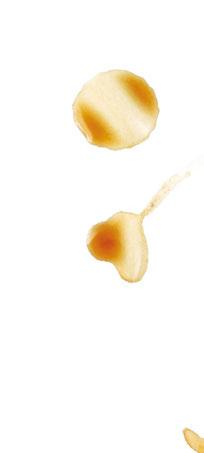
Chapman says Grodski and Barrera had something no one else did: They knew a lot about coffee and had been putting that knowledge into practice with hard work. And they saw their mission, in part, as being part of a community.
“They came over and they brought this tablecloth, and these beautiful ornate
Inside Cocoa Cinnamon.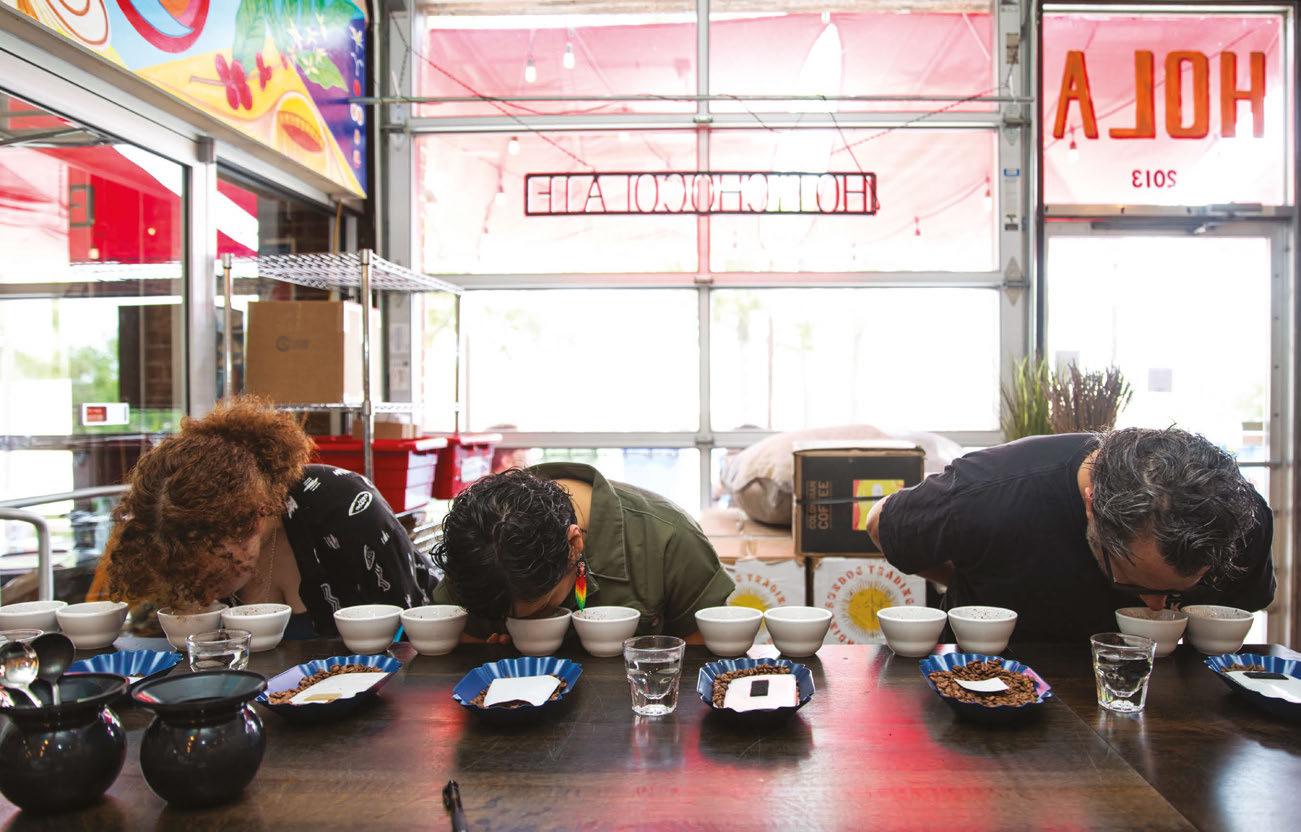
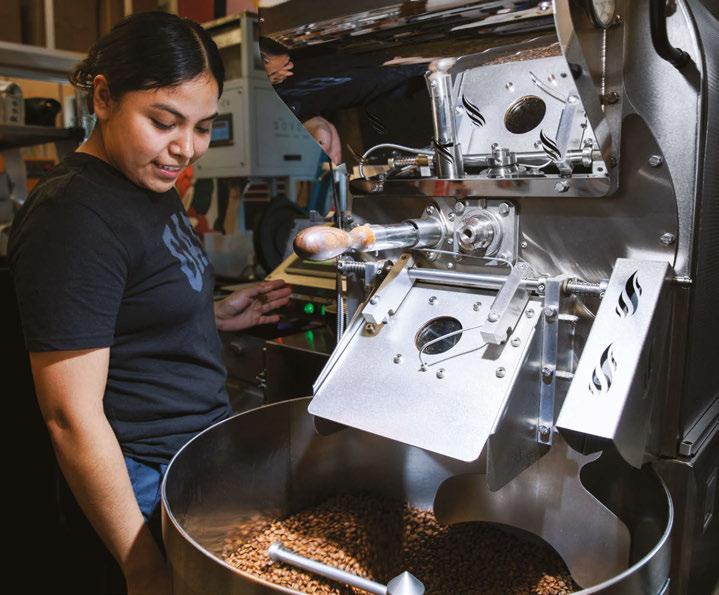

coffee pots, and silver- and gold-covered chocolates,” says Chapman. “And some really good coffee! Their opening statement was, Bob, we like the way that you are curating the street.”
Chapman ended up cosigning a business loan for the couple to get started. The flagship Cocoa Cinnamon, across from Geer St. Garden and near an elementary school, has cozy indoor seating and ample outdoor tables, with lots of planters and string lights around an awning. Offerings at Cocoa Cinnamon have plenty of coffeeshop staples: espresso, drip coffees and pastries. But they’ve also got creative coffee tonics that incorporate flavors like peach, pomegranate and blueberry; house lattes with cayenne or mole-inspired flavors; and freshly made churros.
Once the business started doing well, they stumbled into a second location a bit further west, closer to the campus of Duke University. A similarly friendly arrangement with the landlord helped get that storefront off the ground. Around the same time they found a third spot — their time in Durham building connections was vital to that one as well — with enough room to build a roastery and start buying their own beans.
The business was never just about brewing coffee. Barrera had experience on the roasting side from the coffee shop in Cherokee, and both he and Grodski wanted to find a deeper engagement with farmers around the world and to offer their customers something unique. This new side of the business needed to be built on the principles of fair trade.
“As we started roasting our own beans, I was still wanting to have an array of coffees on the menu that still provided that tasting experience while connecting with how to do this in a way that’s sustainable, and that takes into account all of the dynamics of what it takes to produce coffee,” says Grodski, who was also interested in working with coffee growers whose experiences she could relate to. “Being a woman in the roasting industry wasn’t as common. Let alone
who I was talking to on the sourcing side: the importers were predominantly men. So I was just kind of seeking out other women to connect with — specifically women of color. And that kind of just led down this path, making these beautiful connections.”
One of those women, Phyllis Johnson, runs BD Imports out of Georgia and founded the Coffee Coalition for Racial Equity in 2020, a nonprofit focused on creating opportunities for Black Americans in the industry. Much of her importing is from Brazil, through Black farmers
deliberate about hiring and cultivating those employees with fair wages. Among their nearly 40 employees, the base hourly rate is $17.60, and they’ve had some employees rise through the company over the course of many years. But Grodski and Barrera also wanted to make sure the people working for them reflected the communities that make a city like Durham as multifaceted as it is.
“Our team makeup is 92% women or nonbinary folks. We represent 10 countries, eight languages; we’re a very diverse team,” Barrera says. “We have a Span-
Both Barrera and Grodski wanted to find a deeper engagement with farmers around the world and to offer their customers something unique.
who own their land, a rarity in the business.
“Brazil’s coffee industry was basically built on the backs of Black people through slavery, and that’s what made Brazil become the leading country of coffee,” Grodski says. “It’s actually the country that affects the price value that you buy coffee at. When Brazil has a bad year, the price of coffee goes up. When Brazil has a good year, the price of coffee goes down.”
Being mindful about the dynamics and history of coffee was something Grodski and Barrera wanted to do as they expanded the business, even if it meant paying a little more for beans; the approach of getting the cheapest price for maximum profit wasn’t one they wanted to take. “If you think about coffee’s origins, they come from some of the poorer places in the world. There can be this imbalance, and our approach is more of, how do you do this as a partnership?” Barrera says. “How do you connect quality, relationship and impact? If you’re bringing all of those three together in an ongoing rooted way, it can create these relationships that last through time and can cumulatively build much more sustainable, equitable, thoughtful and delicious outcomes.”
ish-speaking person working here at all times, and when we first opened, we had three people who spoke almost no English, but their co-worker was bilingual. Through that experience, it was like, if you’re going to come into the shop, you have to be willing to wing it with our staff.”
Maricarmen Paz Hernandez, who manages the roastery, started as a barista when she was 17 — she’s now 24. “It’s really a privilege to be growing with a company like this, that provides opportunities to grow — especially since I’m a Latina,” Hernandez says. “We’re Latina-led and Latina-forward, and that’s not really normalized in a coffee roastery.”
As the roasting side expanded — they’re currently working on a larger facility to accommodate its growth — Little Waves has stuck to the principles they started with: open dialogue with a community, hard work and efficiency. It’s a delicate balance, but they see their success as a way to address the lingering effects of colonialism — abroad and at home.

“It’s just kind of bringing that history and that presence to the present day and shining a light on that representation that we want to keep seeing,” says Grodski.
Similarly, part of the Little Waves ethos about community also means being
“And our guests love the coffee,” adds Barrera.


From Seagrove to the world beyond, Ben Owen III shares his pottery


TThe work of Ben Owen III is earthen and practical, but also brightly hued and sculptural. It fits in a hand for morning coffee, but it’s also the lofty centerpiece of elegant spaces across the world. From the Sun Valley Resort in Idaho to the Ritz-Carlton in Tokyo to The Umstead Hotel & Spa in Cary, where his sculptural vessels fill spotlit niches and his handmade plates grace every table, Owen’s art provides beauty and function.
Pottery is one of the oldest human inventions, going back to pre-Neolithic times. Earth into clay, clay into pots, pots into fire, vessels out. Also unchanged: all hands on deck to get it done. It takes a team to keep a wood-fired kiln’s flames stoked and blazing 24 hours a day for days on end. Like farmers raising a barn, potters fire a kiln together because they need each other. It’s what they do.
Owen Jr., built the foundations for Seagrove’s modern pottery community; before them, as early as the late 1700s, their forefathers arrived from England, making and selling clay vessels to early settlers. Owen III works today on the same site his grandfather did.
“He was a great teacher and a great mentor for me,” Owen says, “showing me the fundamentals, building all those skills.” Starting at the age of 9, Owen went out to his grandfather’s studio every day to make
Owen says. “How can I make the piece even better than I did last time?”
That commitment has taken his work not only all over the world but has paved the way for its inclusion in museum collections including the Smithsonian Museum of Art, the Museum of Fine Arts in Boston, the Gregg Museum of Art & Design, and in private collections. His work, in its various manifestations, has a timelessness about it, even when glazed in crystalline turquoise or lilypad green.
Potters can’t always predict what will emerge from the fire, what that day’s particular combination of clay and heat, minerals and weather will produce.
Owen was born to this life, born with Seagrove clay beneath his feet. His father and grandfather, Ben Owen Sr. and Ben
pots. During these sessions, his grandfather taught Owen technique and aesthetics as well as principles: how important it was to challenge oneself, to learn from mistakes, to greet change with enthusiasm, to eschew mediocrity. To “never sell his seconds.”
“I’m continually trying to find ways to refine the technique and my process,”
“I’m always experimenting,” he says. “A lot of people know us for our red glaze, but in recent years, I’ve been making glazes from nature. Recreating things I’ve seen hiking with my son… looking at textures, lichen on a stone, moss on a tree. It’s interesting to think, Could I make a glaze that would create that effect?”
Some of Owen’s pieces are finished in electric or gas-fired kilns, others in his wood-fired groundhog kiln. To witness Owen firing this kiln — a gourd-shaped, 30-foot-long structure dug partway down into the earth, hence the name — is to

Clockwise from top: Young Ben Owen III learns pottery skills from his grandfather; pottery loaded into a kiln; Owen working clay on a pottery wheel; Owen with with a commission for a hotel in Turks & Caicos.




Clockwise from top: A group of finished pots inside a wood kiln; Owen throws a pot on wheel; Owen holding a finished piece; Owen working the rim of a pot on the wheel.

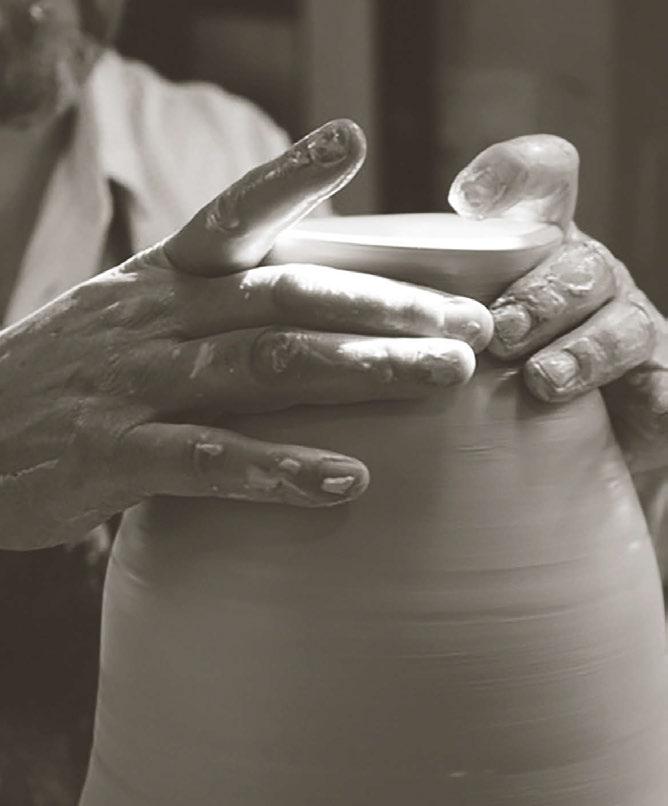


witness a multi-day, group massive effort, only accomplished a few times a year.
One recent morning at his studio in Seagrove, Owen was busy completing a 5-foot-tall, 400-pound, bottle-shaped vessel for the Amanyara resort in Turks & Caicos, one of nine large pieces commissioned by the property. The fire in the kiln had been going for twelve hours, and it would be another 36 before it was done. Owen slid a few slats of wood into a slot in the side of the chamber, turning to laugh at a joke from his friend Stan Simmons, a fellow potter there to help keep the fire going at temperatures reaching 2,350 degrees Fahrenheit. Another potter, Fred Johnston, was also on hand. Both men had pots of their own in the kiln. They waited.
“It’s like a jigsaw puzzle,” he said, gesturing to his kiln, explaining how he fits 400 pots inside. Part of it is tactical: some glazes do well high up, some pots need to be closer to the fire. Some of it is logistical. “Right now,” Owen says, watching flames shoot out of a blowhole-like chimney pipe, “Right now it’s heating up fast. Right now, there’s more fuel than there is oxygen.”
Potters can’t always predict what will emerge from the fire, what that day’s par-
ticular combination of clay and heat, minerals and weather will produce. “Colors, or finishes on pots, are almost like sunsets,” Owen says. “Each day, it’s a little different, and depending on what’s present — just as the clouds, or the temperature, the atmosphere all affect the sunset, our glazes can react the same way. We learn to accept that. We try to control these things to the best of our ability, but we have to remind ourselves that our materials are constantly changing. And sometimes it can be a nice surprise.”
A few steps from this kiln, in the late 1990s, Owen built his own studio, right behind the one where his grandfather taught him. The newer spot is spacious, with separate workstations for different kinds of clay. There are pots in various stages of completion, one already 4 feet tall. When it’s complete, this pot will be glazed an earthy blue, weigh about 250 pounds, and stand in the entry of a home in Greensboro.
“In an era of instant gratification, where people can go to the big box stores or a mall for most of their daily needs, we can offer something different,” Owen says. “Especially when they can meet the maker, learn a little bit more about the process, and what makes a potter tick,
and their particular style, and why they use that technique. The work becomes part of the fellowship.”
Owen pictures his blue vessel in place, mentions the conversations he’s had with the collectors who’ve commissioned the piece. He welcomes the chance to work closely with the people who collect his work — some of whom were also collectors of his grandfather’s work — and to get to know them, just as he does with visitors to his region and his studio. The role of ambassador is another he embraces.
“When you can find a way to develop a relationship with an individual customer or just people coming out to visit the area,” he says, “that gives us a springboard to tell people more about what the past has done, and what we’ve been able to build on over the last several generations.”
He’s happy to go farther back, too, 280 or 300 million years or so, back to when the region was covered in the volcanic ash that gave birth to the clay he loves, and he’s happy to bring it back home to now, and to his legacy. “I just count my blessings that we’ve been able to support our family through the making of earthen vessels,” he says. “Really, the end product is how it is received by the people who use it.”


On Oct. 11, WALTER hosted its annual Taste of the Wild event at The MerrimonWynne House. This event celebrates the joy of eating food grown and raised in North Carolina.
This year, WALTER brought in chef Ricky Moore from Durham’s Saltbox Seafood Joint and BBQ master Matthew Register of Southern Smoke in Garland to co-curate a special menu that highlighted North Carolina produce, seafood and meat. Moore boiled whole shrimp with peanuts for an experiential appetizer, then fried cured catfish for his entree, served alongisde his signature Hush-Honeys. Register offered Wagyu sliders as an appetizer, then an entree of grilled pork loin served with a Tasso ham gravy with squash and rice pudding.
Cocktail hour offered a chance to mingle with each other (and try out some fly fishing, too). During dinner, guests heard from the chefs and sponsors to learn about the origins of the meal, local conservation project and each company’s commitment to sustainability in North Carolina.
Special thanks to our presenting sponsor Great Outdoor Provision Co., title sponsor WILDERS, supporting sponsors Green Front Furniture and Fox & Bailey, and event partner Triangle Land Conservancy. Additional thanks go to Fullsteam Brewery, Westgate Wine and Young Hearts Distilling for the drinks, as well as Locals Seafood, The Finch Forest, Garret Wildflower Seed Farm, Attended Events, If It’s Paper, Alphagraphics and the band Old Habits for making the evening a success.
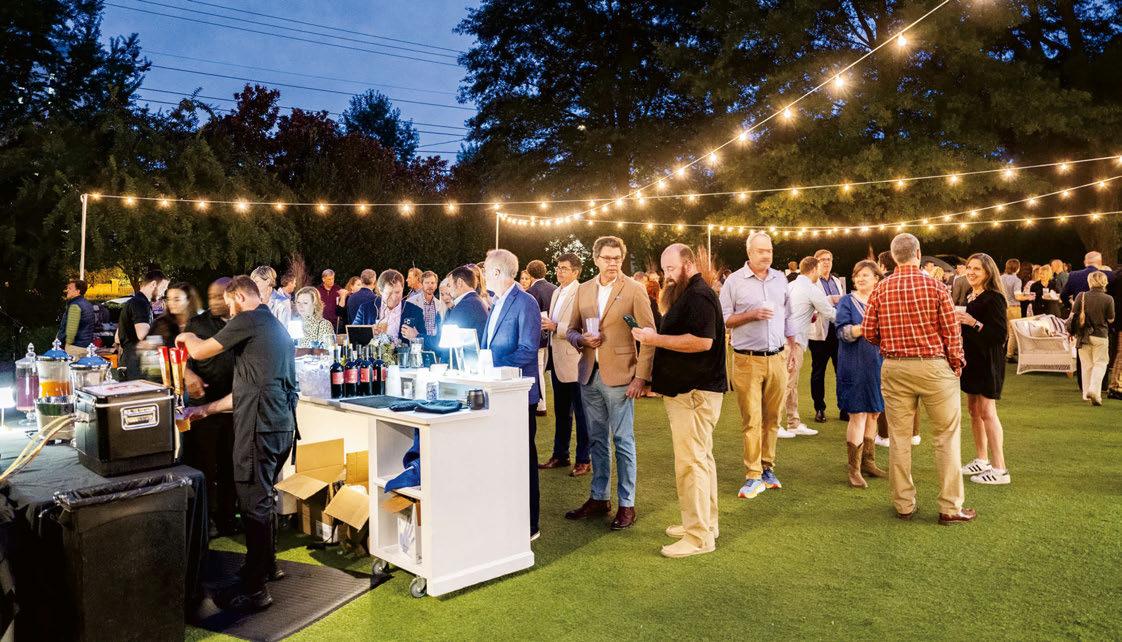 Bryan
Bryan



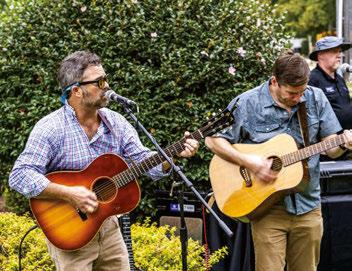

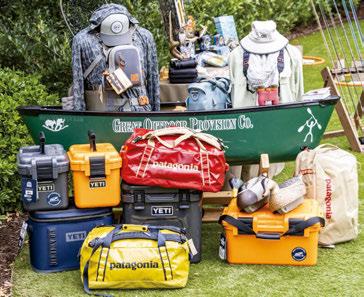


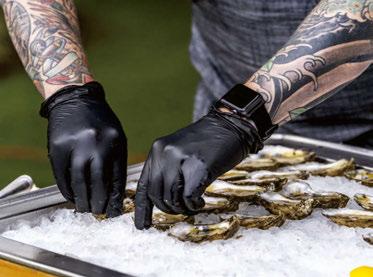

PASSAGES
On Oct. 6, Gallery C hosted a First Friday opening reception for veteran North Carolina painter Gayle Stott Lowry. This was Gallery C’s largest event of the year, with more than 100 guests attending, and celebrated Passages, Lowry's new body of work.



PERFECT AND PINK LUNCHEON
On Oct. 24, Hayes Barton Place hosted a luncheon in collaboration with The Woman’s Club of Raleigh and J.McLaughlin to benefit the Kay Yow Cancer Fund. Retailers J. McLaughlin, Charlotte’s, Marta’s of Raleigh, Lamb’s Ear and DressCode Style offered a fashion show, and HL Catering provided lunch.

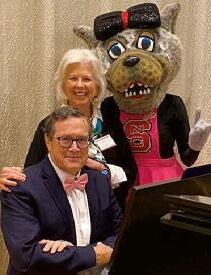

 Marriott Sheldon, Marriott Little, Corneille Little
Marriott Sheldon, Marriott Little, Corneille Little



Otherwise known as Gingerbread, Hot Cocoa, & Peppermint Cookies! Give the gift of happiness this holiday season. Ella’s Popcorn Holiday Trio Gift Box includes three comfort flavors. Hot Cocoa is brimming with homemade Dutch Cocoa and toasted marshmallow caramel then studded with nuggets of joy; teeny-tiny marshmallows. Gingerbread proudly boasts of the classic holiday flavors, with a snappy crunch and a warm ginger finish. Peppermint Cookie-O takes your taste buds on a magical sleigh ride through snowy pepper minty mountaintops.
Order now and save!
Receive free shipping when you use code: WALTER

On Oct. 27,
for the evening.

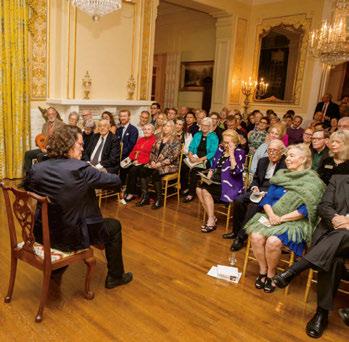
 Tyler
Gallion
CHAMBER MUSIC GALA
Chamber Music Raleigh hosted its 82nd Season Gala at the North Carolina Executive Mansion. Pianist Natasha Paremski and Grammy-winning cellist Zuill Bailey performed
Natasha Paremski, Mary J.C. Cresimore, Zuill Bailey
Tyler
Gallion
CHAMBER MUSIC GALA
Chamber Music Raleigh hosted its 82nd Season Gala at the North Carolina Executive Mansion. Pianist Natasha Paremski and Grammy-winning cellist Zuill Bailey performed
Natasha Paremski, Mary J.C. Cresimore, Zuill Bailey


SNEAKER BALL
On Oct. 10, more than 350 friends, volunteers and partners joined to honor 10 years of Note in the Pocket’s impact on thousands of area children and families, as well as its expansion into Durham County. Emcees Kim and Penn Holderness welcomed guests and introduced speakers Margaret Symonds, Leslie Covington and Dallas Bonavita.





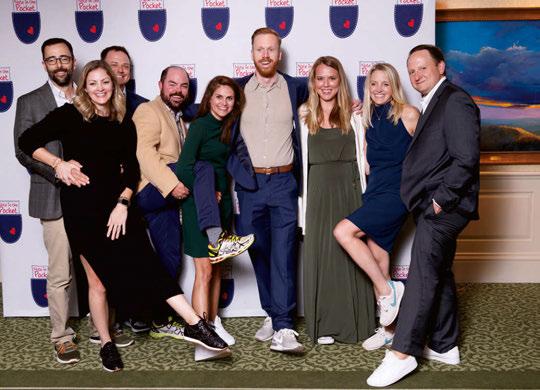 Marc Brady
Penn Holderness, Kim Holderness
James Buck, Chris Williams, MC Karahalios, Dylan Karahalios, Ashley Rushin, Sarah Caldwell, Chris Caldwell, Sarah Williams, Christi Keating, Mike Keating, Nicole Olsen, Iver Olsen, Adrienne Buck, Annie Gault, Kathleen Bove, Mike Bove, Matt Gault, Steve Rushin
Shakeda Muldrow, Dallas Bonavita
Marc Brady
Penn Holderness, Kim Holderness
James Buck, Chris Williams, MC Karahalios, Dylan Karahalios, Ashley Rushin, Sarah Caldwell, Chris Caldwell, Sarah Williams, Christi Keating, Mike Keating, Nicole Olsen, Iver Olsen, Adrienne Buck, Annie Gault, Kathleen Bove, Mike Bove, Matt Gault, Steve Rushin
Shakeda Muldrow, Dallas Bonavita
INSPIRED TO DREAM GALA
The Inspired to Dream Fundraising Gala, hosted by Dream Upward Foundation in collaboration with Inspiring Minds-RDU, was an overwhelming success. The event at the COR Museum featured district court judge Dorothy Mitchell and Dr. Roderick Heath, vice chancellor of Fayetteville State University.

NIGHTMARE ON SOUTH STREET
On Oct. 27, the Carolina Ballet hosted Nightmare on South Street, a Halloween party with a short performance and a costume contest with celebrity judges.




PART OF THE FABRIC OF RALEIGH SINCE 1899
PART OF THE FABRIC OF RALEIGH SINCE 1899
Our patients receive state-of-the-art care in a warm, professional, safe and friendly environment. We welcome new patients!
Our patients receive state-of-the-art care in a warm, professional, safe and friendly environment. We welcome new patients!


OUR SIGNATURE SERVICES INCLUDE:
OUR SIGNATURE SERVICES INCLUDE: Comprehensive & Cosmetic Dental Care
Comprehensive & Cosmetic Dental Care
Same-Day CEREC Crowns
Same-Day CEREC Crowns
Suresmile Clear Aligner Orthodontics
Invisalign Orthodontics
Dental Implants
Dental Implants
Sleep Apnea
Sleep Apnea
TMJ Therapy
TMJ Therapy
919-782-0801 www.drgregweaver.com
New location: 3201 Glenwood Ave. Suite 301 Raleigh, NC 27612 • 919-782-0801 www.drgregweaver.com





Keep an eye out for festive answers that only a local would know!
by RACHEL SIMONACROSS
1. Busy hosp. areas
5. Radioactivity cleanup, briefly
10. Have _ _ in one’s bonnet
14. The _ at Red Hat, where you can ice skate each winter
15. Greek muse of love poetry
16. Pullen _, home of the Holiday Express
17. Quaint pincushion
18. _ Night Raleigh, annual WRAL downtown event
19. Annoyingly smug one
20. North Carolina _, which plays the Holiday Pops
22. Gives one’s thoughts
24. 1990s fad game discs
25. Man _ _ Mancha (stage musical)
26. Workers with a van
29. Double _ (pun variety)
33. It’s dropped in Raleigh on New Year’s Eve
34. Run, as colors
35. _ of the Season, NC Master Chorale’s holiday concert
36. There are two in Carolina Ballet’s The Nutcracker
37. Certain Indonesian
38. Silent performer
39. Do damage to
40. Hollowed out, like an apple
41. Common skincare product
42. Ore-processing facilities
44. Shipments
ACROSS
1Busy hosp. areas
45. Some Dadaist art pieces
46. Shakespeare, for example
5Radioactivity cleanup, briefly
10Have _ _ in one's bonnet
47. Raleigh _ Theatre, where you’ll find Cinderella during the holidays
14The _ at Red Hat, where you can ice skate each winter
50. They light up a Chinese festival in Koka Booth Amphitheatre
15Greek muse of love poetry
54. French brainstorm result
55. Zorro’s weapon
57. _-Cola
33It's dropped in Raleigh on New Year's Eve
12. One of the Great Lakes
34Run, as colors
35'_ of the Season', NC Master Chorale's annual holiday concert
50They light up a Chinese festival in Cary's Koka Booth Amphitheatre each year
13. Some med. tests
21. Devil feature
54French brainstorm result
6TV's Andrews and Burnett
7Raleigh suburb with plenty of holiday fun
8Extra NFL periods
9Seldomly
10Ancient Rome's _
11Angus _, restaurant whose famous lights display was shown earlier in this magazine
12One of the Great Lakes
13Some med. tests
21Devil feature 23_ one's case (went court)
25First draft picks
26Some polite titles
27Philosopher with a "razor"
28Your, in French
29Evening with _, popular event at Marbles Kids Museum
30Spinning records at party
31Juliet's beloved
32Ogling ones
34Comedian Roseanne and others
37'My Cousin Vinny'
38Raleigh neighborhood with plenty of lit-up houses during the holidays
40Computer key used shortcuts
41Like unripe blueberries
43Most tardy
36There are two in 'The Nutcracker', performed by the Carolina Ballet every holiday season
16Pullen _, home of the Holiday Express featuring train rides, carousels and more
17Quaint pincushion
58. High Country _, from whom lots of locals buy Christmas trees
18_ Night Raleigh, annual WRAL downtown event
19Annoyingly smug one
59. A Christmas _, production starring Ira David Wood III (for the last time!)
60. Some tiny batteries
20Carolina _, who traditionally perform 'Holiday Pops'
61. Change the text
22Gives one's thoughts
241990s fad game discs
63. Lupino and Tarbell
25'Man _ _ Mancha' (stage musical)
26Workers with a van
29Double _ (pun variety)
DOWN
1. Makes mad
2. New York or London
3. E pluribus _, words on a dollar bill
4. Nautical captains
5. Clears, as a windshield
6. TV’s Andrews and Burnett
23. _ one’s case (went to court)
55Zorro's weapon
57_-Cola
25. First post-B.C. year
37Certain Indonesian
26. Some polite titles
58High Country _, popular option for buying Christmas trees
38Silent performer
27. Philosopher with a “razor”
39Do damage to
28. Your, in French
40Apple castoffs
41Common skincare product
44One of many that light up a Historic Oakwood holiday tour
46Noble title
47Word seen after "true" or "still"
48Guilty "Who ate the cookie?" response
29. Evening with _, a joyful event at Marbles Kids Museum
42Ore processing facilities
59'A Christmas _', Raleigh production starring Ira David Wood III as the Scrooge (for the last time!)
30. Spinning records at a party
44Shipments
60Some tiny batteries
61Change the text
31. Juliet’s beloved
45Some Dadaist art pieces
32. Ogling ones
46Shakespeare, for example
62. Adler, who outsmarted Sherlock Holmes
62Adler who outsmarted Sherlock Holmes
63Lupino and Tarbell
34. Comedian Roseanne and others
49Actress Hatcher or Garr
50Passed-down
DOWN
37. My Cousin Vinny star
47_ Theatre, which shows 'Cinderella' during the holidays
7. Raleigh suburb with plenty of holiday fun
8. Extra NFL periods
9. Seldomly
10. Ancient Rome’s _ Way
11. Angus _, restaurant whose light display is highlighted in this issue
1Makes mad
2New York or London
38. Raleigh neighborhood that holds the oldest house in the city in its original site
3E pluribus _, words on a dollar bill
40. Computer key used in shortcuts
4Nautical captains
41. Like unripe blueberries
43. Most tardy
5Clears, as a windshield
44. What you’ll find glowing in Historic Oakwood windows
46. Noble title
47. Word seen after “true” or “still”
48. Guilty “Who ate the last cookie?” response
49. Actress Hatcher or Garr
50. Passed-down stories
51. Holt _, Cary spot known for its light show
52. College sports org.
53. Give lip to
56. Civil or Revolutionary event
Find answers on page 90

Your children. Your family. Your health. Your well-being. Your place.

From pregnancy and childbirth to mammograms, menopause and more, the care is as compassionate as it is comprehensive. Covering everything and anything female from outpatient and inpatient surgery to specialty and subspecialty care, and the most advanced technology. After all, when it comes to you, your health and your family, you’re the decision maker. And the decision is clearly WakeMed Women’s.
